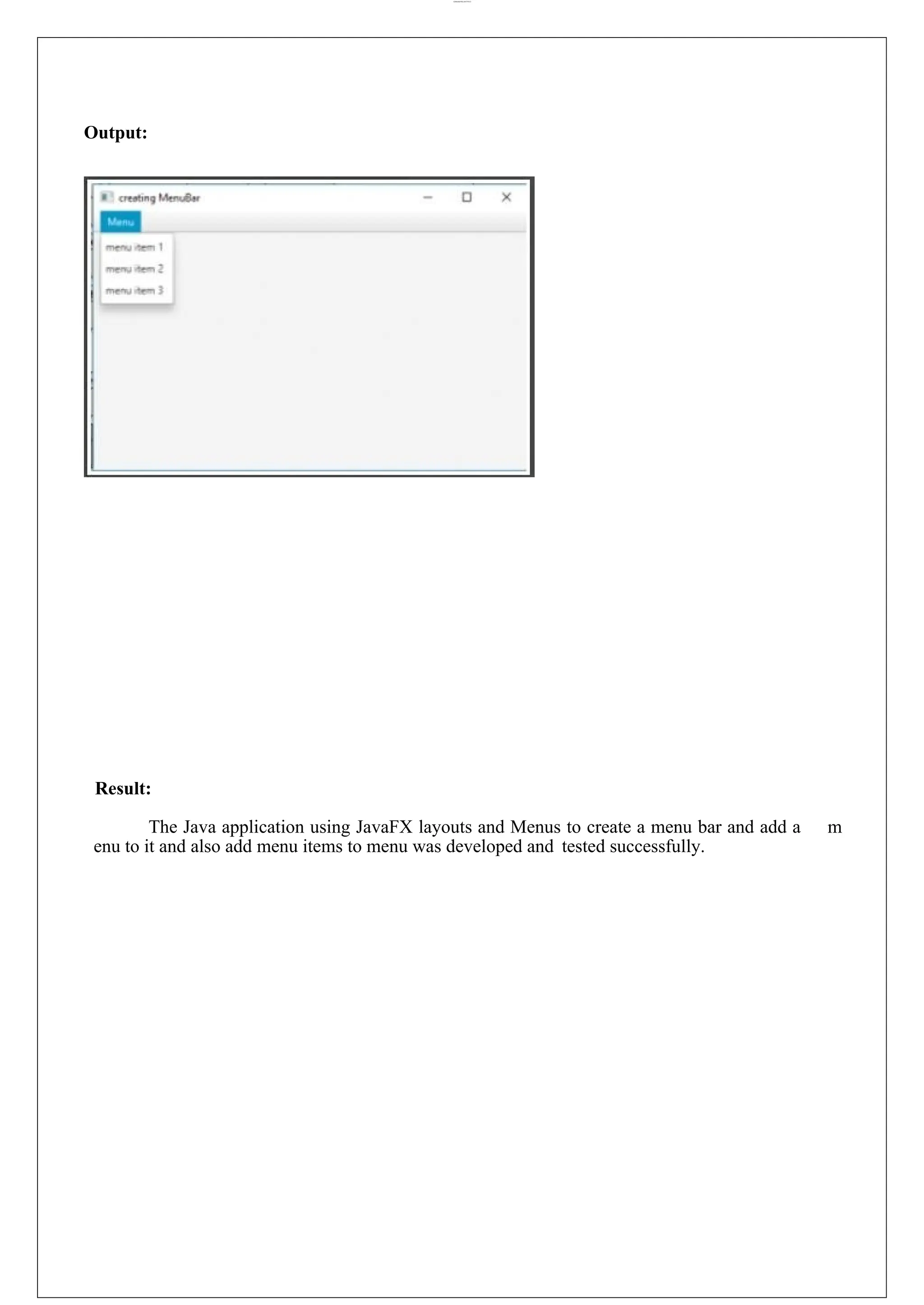The document is a Java programming lab manual that includes examples for various algorithms and data structures such as linear search, binary search, selection sort, insertion sort, stack, and queue operations, as well as an employee payroll system. Each section outlines the aim, algorithm, coding implementation, and results of the respective program, demonstrating successful execution. The code examples utilize exception handling and encapsulate functionality for user interaction and data processing.

![lOMoARcPSD|44777612 Ex.No: 1 a Java Program for Sequential Search (Linear Search) Date: Aim: To create a Java program for Sequential search which is also called as Linear Search. Algorithm: Step 1 Start the process. Step 2 Let the element to be search be x. Step 3 Start from the leftmost element of arr[] and one by one compare x with each element of arr[]. Step 4 If x matches with an element then return that index. Step 5 If x doesn’t match with any of elements then return -1. Step 6 Exit from the process. Step 7 Stop the process. Coding: class GFG { // Function for linear search public static int search(int arr[], int x) { int n = arr.length; for (int i = 0; i < n; i++) { if (arr[i] == x) return i; } return -1; } public static void main(String args[]) { int arr[] = { 2, 3, 4, 10, 40 }; int x = 10; // Function Call int result = search(arr, x); if (result == -1)](https://image.slidesharecdn.com/cs3381-oops-lab-manual-wordf-240805065617-a87611fa/75/cs3381-object-oriented-programming-ab-manual-2-2048.jpg)

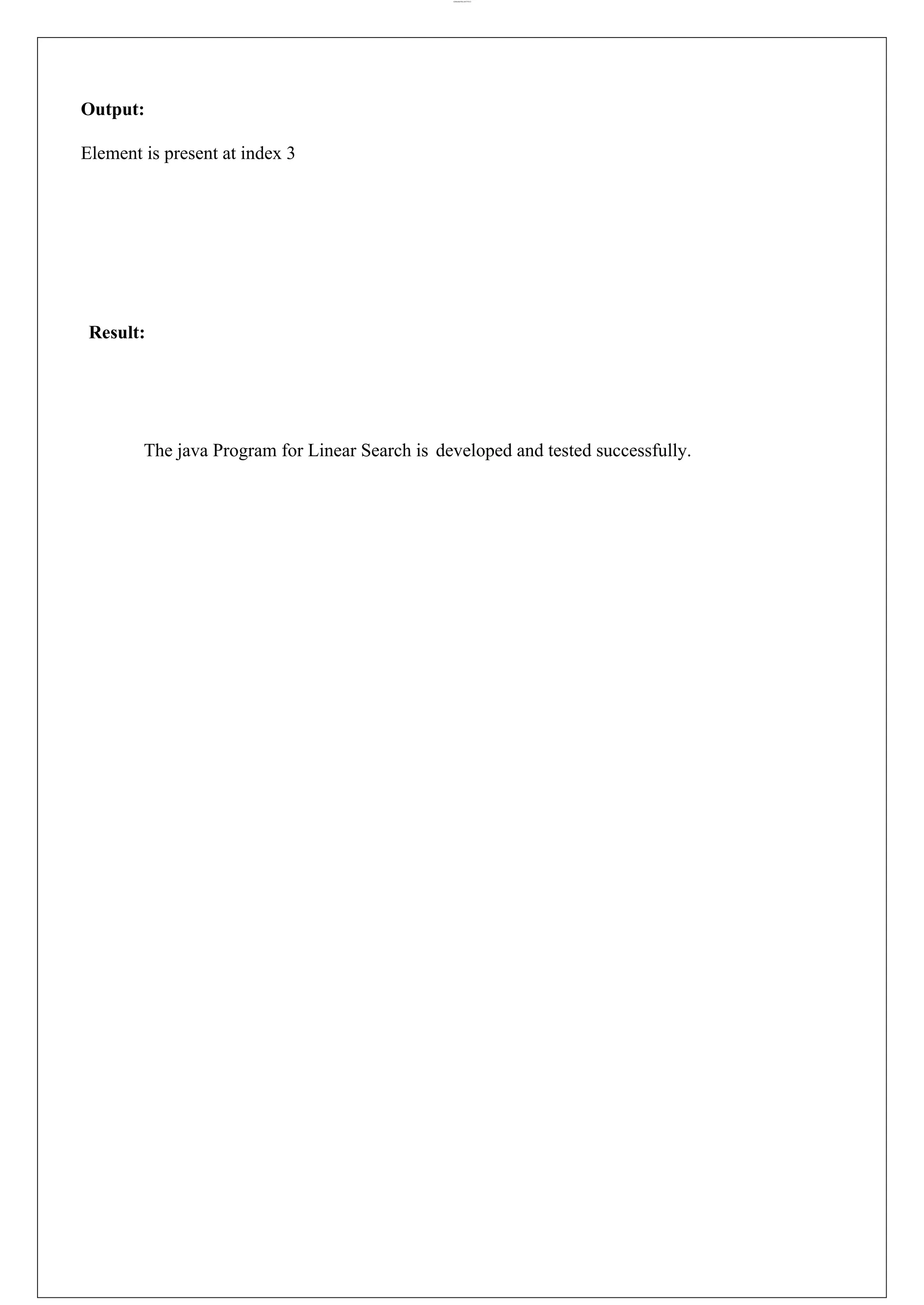
![lOMoARcPSD|44777612 Ex.No: 1 b Java Program for Binary Search Date: Aim: To create a Java program for Binary search to find a given element. Algorithm: Step 1 Start the process. Step 2 Compare x with the middle element. Step 3 If x matches with middle element, we return the mid index. Step 4 Else If x is greater than the mid element, then x can only lie in the right half subarray after the mid element. So we recur for right half. Step 5 Else (x is smaller) recur for the left half. Step 6 Exit from the process. Step 7 Stop the process. Coding: class BinarySearch { int binarySearch(int arr[], int l,int r, int x) { if (r >= l) { int mid = l + (r - l) / 2; if (arr[mid] == x) return mid; if (arr[mid] > x) return binarySearch(arr, l,mid - 1, x); // Else the element can only be // present in right subarray return binarySearch(arr, mid + 1,r, x); } return -1; } public static void main(String args[]) { BinarySearch ob = new BinarySearch(); // Given array arr[] int arr[] = { 2, 3, 4, 10, 40 }; int n = arr.length; int x = 10; // Function Call int result = ob.binarySearch(arr, 0,n - 1, x); if (result == -1) System.out.println("Element "+ "not present"); else } }](https://image.slidesharecdn.com/cs3381-oops-lab-manual-wordf-240805065617-a87611fa/75/cs3381-object-oriented-programming-ab-manual-5-2048.jpg)
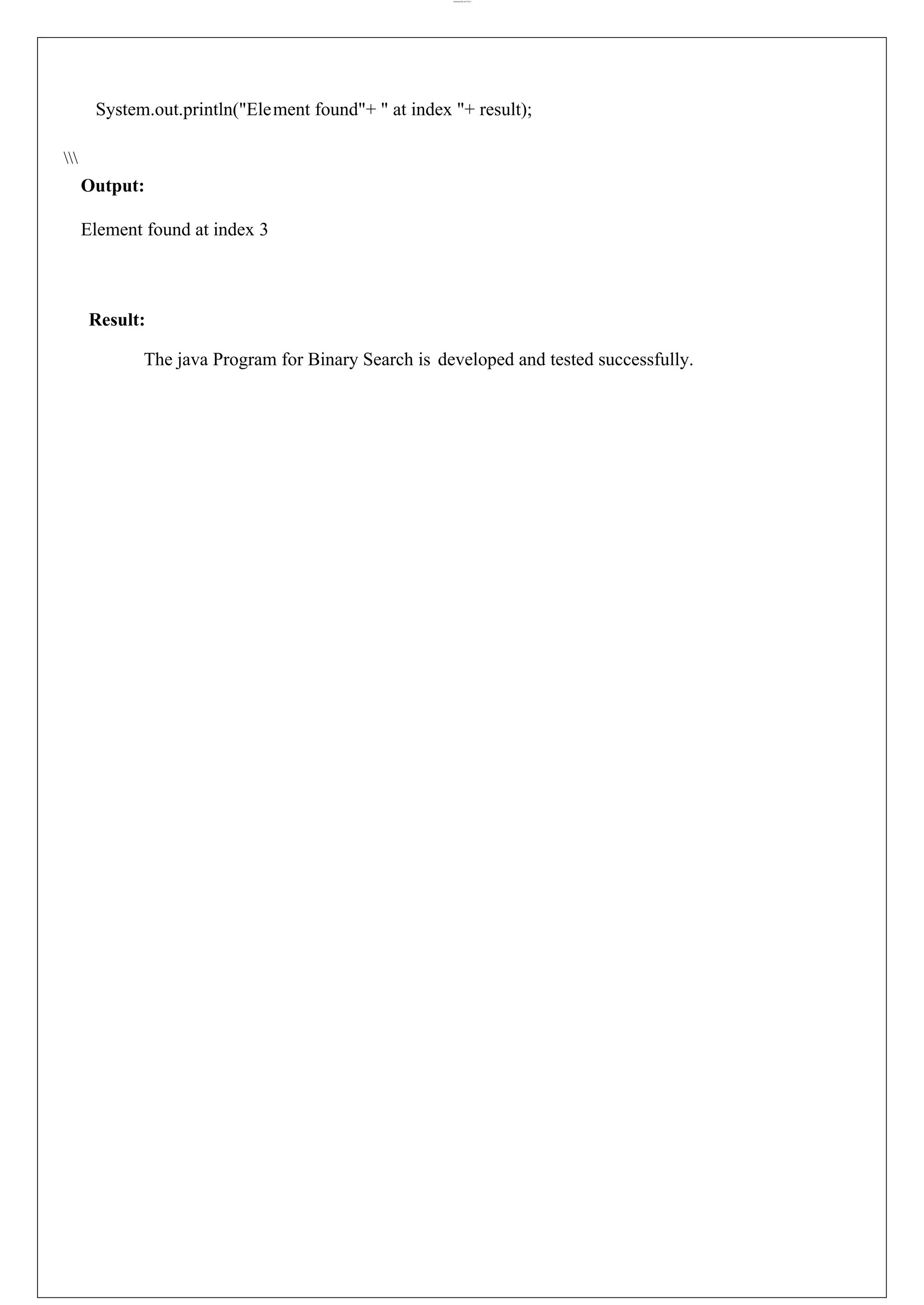
![lOMoARcPSD|44777612 Ex.No: 1 c Java Program for Selection Sort Date: Aim: To create a Java program for Selection sort to sort the given elements. Algorithm: Step 1 Start the process. Step 2 Initialize minimum value(min_idx) to location 0. Step 3 Traverse the array to find the minimum element in the array. Step 4 While traversing if any element smaller than min_idx is found then swap both the values. Step 5 Then, increment min_idx to point to the next element. Step 6 Repeat until the array is sorted. Step 7 Stop the process. Coding: class SelectionSort { void sort(int arr[]) { int n = arr.length; for (int i = 0; i < n-1; i++) { int min_idx = i; for (int j = i+1; j < n; j++) if (arr[j] < arr[min_idx]) min_idx = j; int temp = arr[min_idx]; arr[min_idx] = arr[i]; arr[i] = temp; } } void printArray(int arr[]) { int n = arr.length; for (int i=0; i<n; ++i) System.out.print(arr[i]+" "); System.out.println(); }](https://image.slidesharecdn.com/cs3381-oops-lab-manual-wordf-240805065617-a87611fa/75/cs3381-object-oriented-programming-ab-manual-7-2048.jpg)
![lOMoARcPSD|44777612 public static void main(String args[]) { SelectionSort ob = new SelectionSort(); int arr[] = {64,25,12,22,11}; ob.sort(arr); System.out.println("Sorted array"); ob.printArray(arr); } } Output: Sorted array: 11 12 22 25 64 Result: The java Program for Selection Sort is developed and tested successfully.](https://image.slidesharecdn.com/cs3381-oops-lab-manual-wordf-240805065617-a87611fa/75/cs3381-object-oriented-programming-ab-manual-8-2048.jpg)
![lOMoARcPSD|44777612 Ex.No: 1 d Java Program for Insertion Sort Date: Aim: To create a Java program for Insertion sort to sort the given elements. Algorithm: Step 1 Start the process. Step 2 Iterate from arr[1] to arr[N] over the array. Step 3 Compare the current element (key) to its predecessor. Step 4 If the key element is smaller than its predecessor, compare it to the elements before. Step 5 Move the greater elements one position up to make space for the swapped element. Step 6 Stop the process. Coding: class InsertionSort { void sort(int arr[]) { int n = arr.length; for (int i = 1; i < n; ++i) { int key = arr[i]; int j = i - 1; while (j >= 0 && arr[j] > key) { arr[j + 1] = arr[j]; j = j - 1; } arr[j + 1] = key; } } static void printArray(int arr[]) { int n = arr.length; for (int i = 0; i < n; ++i) System.out.print(arr[i] + " "); System.out.println(); } // Driver method public static void main(String args[]) { int arr[] = { 12, 11, 13, 5, 6 }; InsertionSort ob = new InsertionSort(); ob.sort(arr); printArray(arr); } }](https://image.slidesharecdn.com/cs3381-oops-lab-manual-wordf-240805065617-a87611fa/75/cs3381-object-oriented-programming-ab-manual-9-2048.jpg)

![lOMoARcPSD|44777612 Ex.No: 2a Java Application for Stack Data Structure Date: Aim: To create a Java console application for stack. Stack operations must be controlled by exception handling techniques. Algorithm: Step 1: Start the program Step 2: Initialize the necessary variables Step 3: Create a stack, initialize the array and the stack variables Step 4: Create the push function to insert the elements into the stack. Step 5: The push function inserts element at the top and displays stack overflow, if the stack is full. Step 6: Create the pop function to delete the elements from the stack. Step 7: The pop function deletes the element from the top and displays stack empty, if the stack contains no element. Step 8: Create isfull() and isempty() to check whether the stack is full or empty. Step 9: In the main function, perform the operations to insert and delete the elements from the stack. Step 10: Stop the program. Coding // Stack implementation in Java class Stack { // store elements of stack private int arr[]; // represent top of stack private int top; // total capacity of the stack private int capacity; // Creating a stack Stack(int size) { // initialize the array // initialize the stack variables arr = new int[size]; capacity = size; top = -1; } // push elements to the top of stack public void push(int x) { if (isFull()) { System.out.println("Stack OverFlow"); // terminates the program System.exit(1); }](https://image.slidesharecdn.com/cs3381-oops-lab-manual-wordf-240805065617-a87611fa/75/cs3381-object-oriented-programming-ab-manual-11-2048.jpg)
![lOMoARcPSD|44777612 // insert element on top of stack System.out.println("Inserting " + x); arr[++top] = x; } // pop elements from top of stack public int pop() { // if stack is empty // no element to pop if (isEmpty()) { System.out.println("STACK EMPTY"); // terminates the program System.exit(1); } // pop element from top of stack return arr[top--]; } // return size of the stack public int getSize() { return top + 1; } // check if the stack is empty public Boolean isEmpty() { return top == -1; } // check if the stack is full public Boolean isFull() { return top == capacity - 1; } // display elements of stack public void printStack() { for (int i = 0; i <= top; i++) { System.out.print(arr[i] + ", "); } } public static void main(String[] args) { Stack stack = new Stack(5); stack.push(1); stack.push(2); stack.push(3); System.out.print("Stack: "); stack.printStack(); // remove element from stack stack.pop(); System.out.println("nAfter popping out"); stack.printStack(); } }](https://image.slidesharecdn.com/cs3381-oops-lab-manual-wordf-240805065617-a87611fa/75/cs3381-object-oriented-programming-ab-manual-12-2048.jpg)
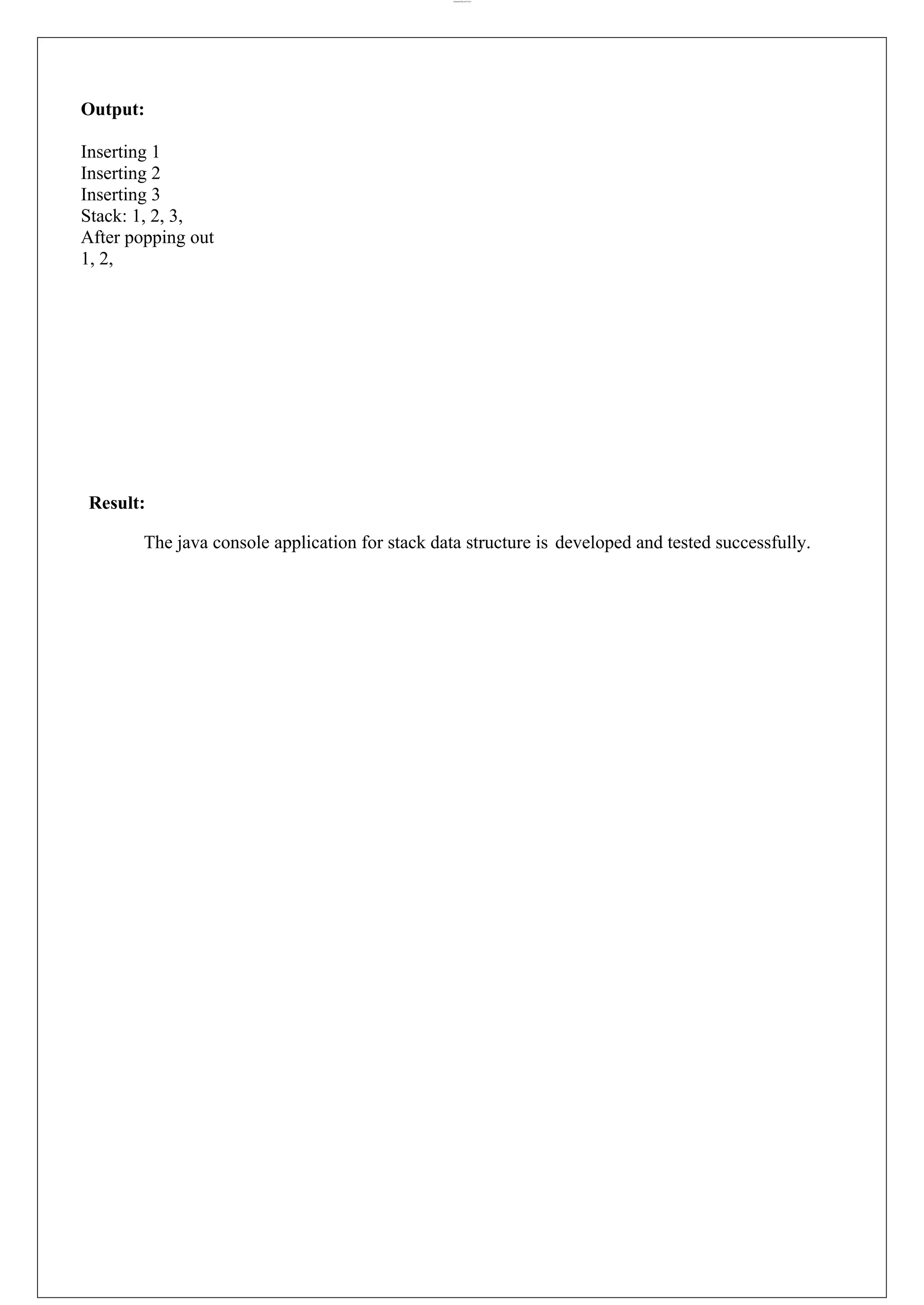
![lOMoARcPSD|44777612 Ex.No: 2b Java Application for Queue Data Structure Date: Aim: To create a Java console application for Queue. Queue operations must be controlled by exception handling techniques. Algorithm: Step 1: Start the program. Step 2: Initialize the necessary variables. Step 3: Initialize the front and rear variables. Step 4: Create the enqueue function to insert the elements into the queue. Step 5: The enqueue function inserts element at the rear and displays queue is full, if the queue is full. Step 6: Create the dequeue function to delete the elements from the queue. Step 7: The dequeue function deletes the element from the rear and displays queue empty, if the queue contains no element. Step 8: Create isfull() and isempty() to check whether the queue is full or empty. Step 9: In the main function, perform the operations to insert and delete the elements from the queue. Step 10: Stop the program. Coding public class Queue { int SIZE = 5; int items[] = new int[SIZE]; int front, rear; Queue() { front = -1; rear = -1; } // check if the queue is full boolean isFull() { if (front == 0 && rear == SIZE - 1) { return true; } return false; } // check if the queue is empty boolean isEmpty() { if (front == -1) return true; else return false; }](https://image.slidesharecdn.com/cs3381-oops-lab-manual-wordf-240805065617-a87611fa/75/cs3381-object-oriented-programming-ab-manual-14-2048.jpg)
![lOMoARcPSD|44777612 // insert elements to the queue void enQueue(int element) { // if queue is full if (isFull()) { System.out.println("Queue is full"); } else { if (front == -1) { // mark front denote first element of queue front = 0; } rear++; // insert element at the rear items[rear] = element; System.out.println("Insert " + element); } } // delete element from the queue int deQueue() { int element; // if queue is empty if (isEmpty()) { System.out.println("Queue is empty"); return (-1); } else { // remove element from the front of queue element = items[front]; // if the queue has only one element if (front >= rear) { front = -1; rear = -1; } else { // mark next element as the front front++; } System.out.println( element + " Deleted"); return (element); } } // display element of the queue void display() { int i; if (isEmpty()) { System.out.println("Empty Queue"); } else {](https://image.slidesharecdn.com/cs3381-oops-lab-manual-wordf-240805065617-a87611fa/75/cs3381-object-oriented-programming-ab-manual-15-2048.jpg)
![lOMoARcPSD|44777612 // display the front of the queue System.out.println("nFront index-> " + front); // display element of the queue System.out.println("Items -> "); for (i = front; i <= rear; i++) System.out.print(items[i] + " "); // display the rear of the queue System.out.println("nRear index-> " + rear); } } public static void main(String[] args) { // create an object of Queue class Queue q = new Queue(); // try to delete element from the queue // currently queue is empty // so deletion is not possible q.deQueue(); // insert elements to the queue for(int i = 1; i < 6; i ++) { q.enQueue(i); } // 6th element can't be added to queue because queue is full q.enQueue(6); q.display(); // deQueue removes element entered first i.e. 1 q.deQueue(); // Now we have just 4 elements q.display(); } }](https://image.slidesharecdn.com/cs3381-oops-lab-manual-wordf-240805065617-a87611fa/75/cs3381-object-oriented-programming-ab-manual-16-2048.jpg)
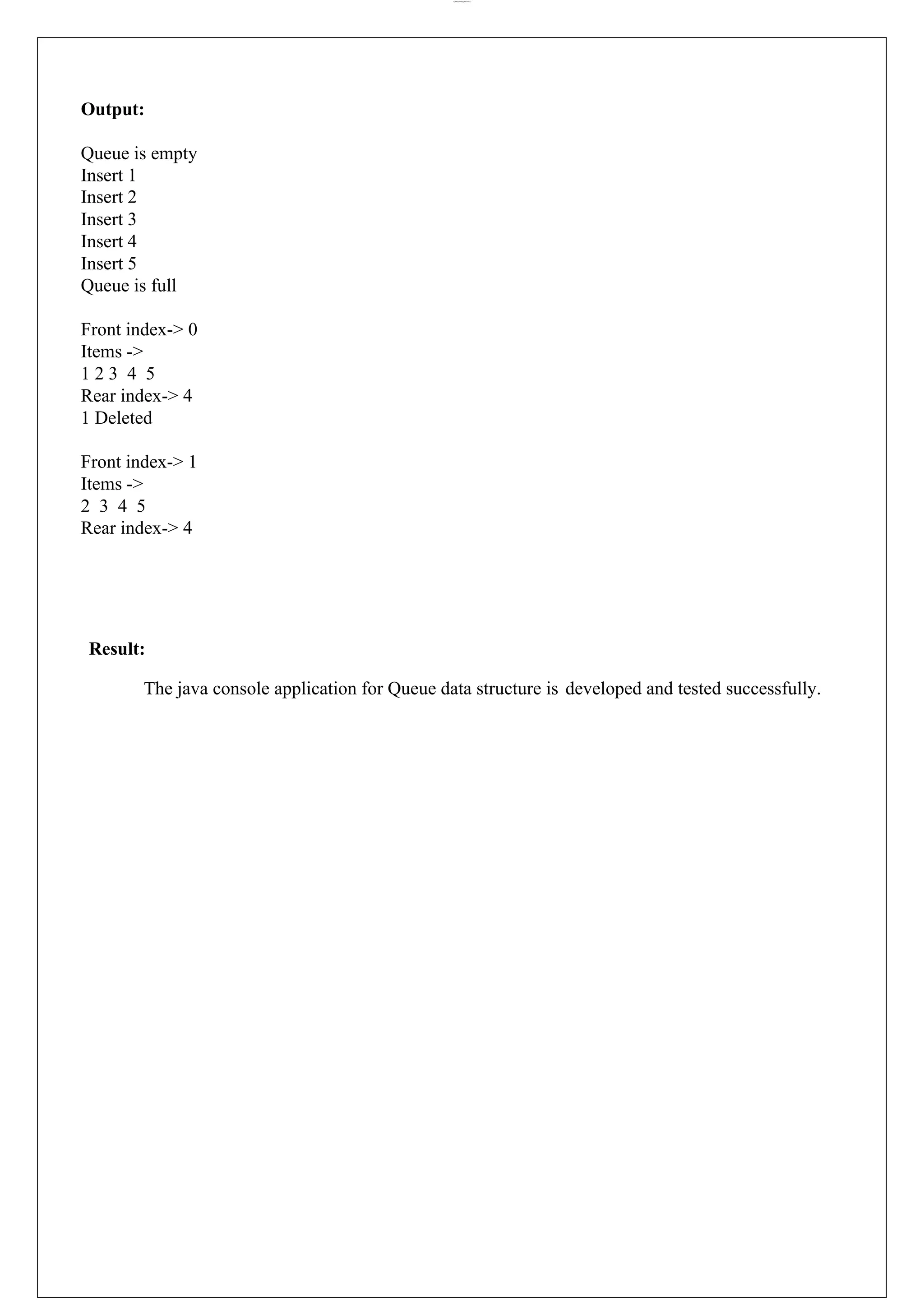
![lOMoARcPSD|44777612 Ex.No: 3 Employee Payroll System Date: Aim: To create a Java console application for employee payroll process management. This project includes Employee and they further classified as Programmer, Assistant Professor, Associate Professor, Professor. Algorithm: Step 1 Start the process Step 2 Prompt the user with converter choice 1. Programmer 2. Assistant Professor 3. Associate Professor 4. Professor 5. Exit and get the choice. Step 3 If user selects a Programmer then proceed to step 4 Step 4 Get the user details [Name, ID, Address, Mail ID and Mobile Number] and goto step 5 Step 5 Proceed to Programmers Payment Processing Step 5.1 Get the basic pay of Programmer Step 5.2 If user enters -1 assume basic pay as 30000 and goto step 15 Step 5.3 Else directly go to step 15 Step 6 If user selects Assistant Professor step 7 Step 7 Get the user details [Name, ID, Address, Mail ID and Mobile Number] and goto step 8 Step 8 Proceed to Assistant Professor Payment Processing Step 8.1 Get the basic pay of Assistant Professor Step 8.2 If user enters -1 assume basic pay as 25000 and goto step 15 Step 8.3 Else directly go to step 15 Step 9 If user selects Associate Professor step 10 Step 10 Get the user details [Name, ID, Address, Mail ID and Mobile Number] and goto step 11 Step 11 Proceed to Associate Professor Payment Processing Step 11.1 Get the basic pay of Associate Professor Step 11.2 If user enters -1 assume basic pay as 40000 and goto step 15 Step 11.3 Else directly go to step 15 Step 12 If user selects Professor step 13 Step 13 Get the user details [Name, ID, Address, Mail ID and Mobile Number] and goto step 14 Step 14 Proceed to Professor Payment Processing Step 14.1 Get the basic pay of Professor Step 14.2 If user enters -1 assume basic pay as 70000 and goto step 15 Step 14.3 Else directly go to step 15 Step 15 Compute Per_Day_Pay = original_basic_pay / no_of_days_in_the_current_month Step 16 Get the number of days worked from user that include Cl, WH, FH and exclude the LOP Step 17 Check no_days_worked <= no_of_days_in_the_current_month. Else display “Error Message” and goto step 18](https://image.slidesharecdn.com/cs3381-oops-lab-manual-wordf-240805065617-a87611fa/75/cs3381-object-oriented-programming-ab-manual-18-2048.jpg)
![lOMoARcPSD|44777612 Step 18 Compute Current_Basic_Pay = Per_Day_Pay * no_days_worked Step 19 Compute Following and Store DA = (Current_Basic_Pay/100) * 97 HRA = (Current_Basic_Pay/100) * 12 PF = (Current_Basic_Pay/100) * 0.1 GROSS_PAY = Current_Basic_Pay + DA + HRA + PF NET_PAY = GROSS_PAY - PF Step 17 Display Payment Details [Name, ID, Address, Mail ID, Mobile Number, BASIC PAY, DA, HRA,PF,GROSS_PAY, NET_PAY]. Step 18 Stop Processing Coding Employee.java package payscale; import java.util.Calendar; import java.util.GregorianCalendar; import java.util.Scanner; class Employee { String emp_name; String emp_id; String emp_address; String emp_mail_id; String emp_mobile_no; int basic_pay; int per_day_pay; int current_basic_pay; int da, hra, pf, gross_pay; int net_pay; int no_of_days_in_current_month; int no_of_days_worked; Calendar cal; Scanner input; Employee() { input = new Scanner(System.in); cal = new GregorianCalendar(); no_of_days_in_current_month = cal.getActualMaximum(Calendar.DAY_OF_MONTH); getUserBasicDetails(); } public void generatePaySlip() { this.da = (this.current_basic_pay / 100) * 97; this.hra = (this.current_basic_pay / 100) * 12; this.pf = (int) ((this.current_basic_pay / 100) * 0.1); this.gross_pay = this.current_basic_pay + da + hra + pf;](https://image.slidesharecdn.com/cs3381-oops-lab-manual-wordf-240805065617-a87611fa/75/cs3381-object-oriented-programming-ab-manual-19-2048.jpg)
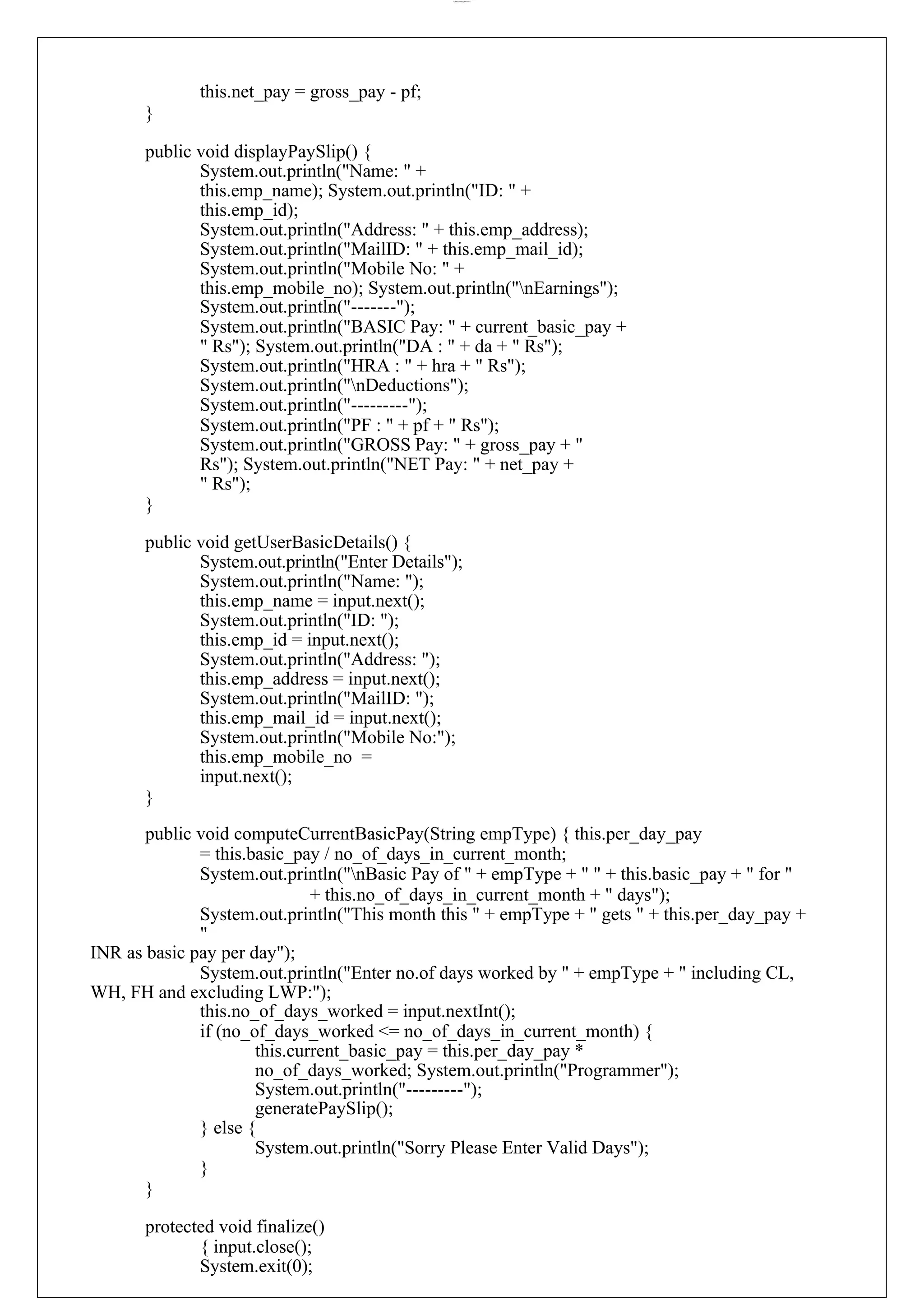

![lOMoARcPSD|44777612 } Programmer.java package payscale; public class Programmer extends Employee { public Programmer() { super(); computeProgrammerPay(); } public void computeProgrammerPay() { System.out.println("Enter Basic pay of Programmer [enter -1 for Default [BP = 30000]]:"); this.basic_pay = input.nextInt(); if (this.basic_pay == -1) { this.basic_pay = 30000; System.out.println("Default Pay Taken"); } computeCurrentBasicPay("Programmer"); generatePaySlip(); displayPaySlip(); } } Assistant Professor.java package payscale; public class AssistantProfessor extends Employee { public AssistantProfessor() { super(); computeAssistantProfessorPay(); } public void computeAssistantProfessorPay() { System.out.println("Enter Basic pay of AssistantProfessor [enter -1 for Default [BP = 25000]]:"); this.basic_pay = input.nextInt(); if (this.basic_pay == -1) { this.basic_pay = 25000; System.out.println("Default Pay Taken"); } computeCurrentBasicPay("AssistantProfessor"); generatePaySlip(); displayPaySlip(); } }](https://image.slidesharecdn.com/cs3381-oops-lab-manual-wordf-240805065617-a87611fa/75/cs3381-object-oriented-programming-ab-manual-22-2048.jpg)
![lOMoARcPSD|44777612 Associate Professor package payscale; public class AssociateProfessor extends Employee { public AssociateProfessor() { super(); computeAssociateProfessorPay(); } public void computeAssociateProfessorPay() { System.out.println("Enter Basic pay of AssociateProfessor [enter -1 for Default [BP = 40000]]:"); this.basic_pay = input.nextInt(); if (this.basic_pay == -1) { this.basic_pay = 40000; System.out.println("Default Pay Taken"); } computeCurrentBasicPay("AssociateProfessor"); generatePaySlip(); displayPaySlip(); } } Professor package payscale; public class Professor extends Employee { public Professor() { super(); computeProfessorPay(); } public void computeProfessorPay() { System.out.println("Enter Basic pay of Professor [enter -1 for Default [BP = 70000]]:"); this.basic_pay = input.nextInt(); if (this.basic_pay == -1) { this.basic_pay = 70000; System.out.println("Default Pay Taken"); } computeCurrentBasicPay("Professor"); generatePaySlip(); displayPaySlip(); } }](https://image.slidesharecdn.com/cs3381-oops-lab-manual-wordf-240805065617-a87611fa/75/cs3381-object-oriented-programming-ab-manual-23-2048.jpg)
![lOMoARcPSD|44777612 Main.java import java.io.BufferedReader; import java.io.IOException; import java.io.InputStreamReader; import java.util.Scanner; import payscale.AssistantProfessor; import payscale.AssociateProfessor; import payscale.Programmer; import payscale.Professor; public class Main { public static void main(String[] args) throws IOException { Programmer aProgrammer; AssistantProfessor aAssistantProfessor; AssociateProfessor aAssociateProfessor; Professor aProfessor; String choice; int n_choice = 0; Scanner userInput = new Scanner("System.in"); while (n_choice != 5) { System.out.println("nnEmployee Payroll System"); System.out.println("***********************n"); System.out.println("1. Programmern2. Assistant Professorn" + "3. Associate Professorn4. Professorn" + "5. ExitnnEnter Your Choice"); choice = new BufferedReader(new InputStreamReader(System.in)).readLine(); n_choice = Integer.parseInt(choice); switch (n_choice) { case 1: case 2: case 3: case 4: case 5: System.out.println("Programmer Selected"); aProgrammer = new Programmer(); break; System.out.println("AssistantProfessor Selected"); aAssistantProfessor = new AssistantProfessor(); break; System.out.println("AssociateProfessor Selected"); aAssociateProfessor = new AssociateProfessor(); break; System.out.println("Professor Selected"); aProfessor = new Professor(); System.out.println("Thank You !!!"); userInput.close(); break; default: System.out.println("Enter valid choice !!!"); break; } } }}](https://image.slidesharecdn.com/cs3381-oops-lab-manual-wordf-240805065617-a87611fa/75/cs3381-object-oriented-programming-ab-manual-24-2048.jpg)
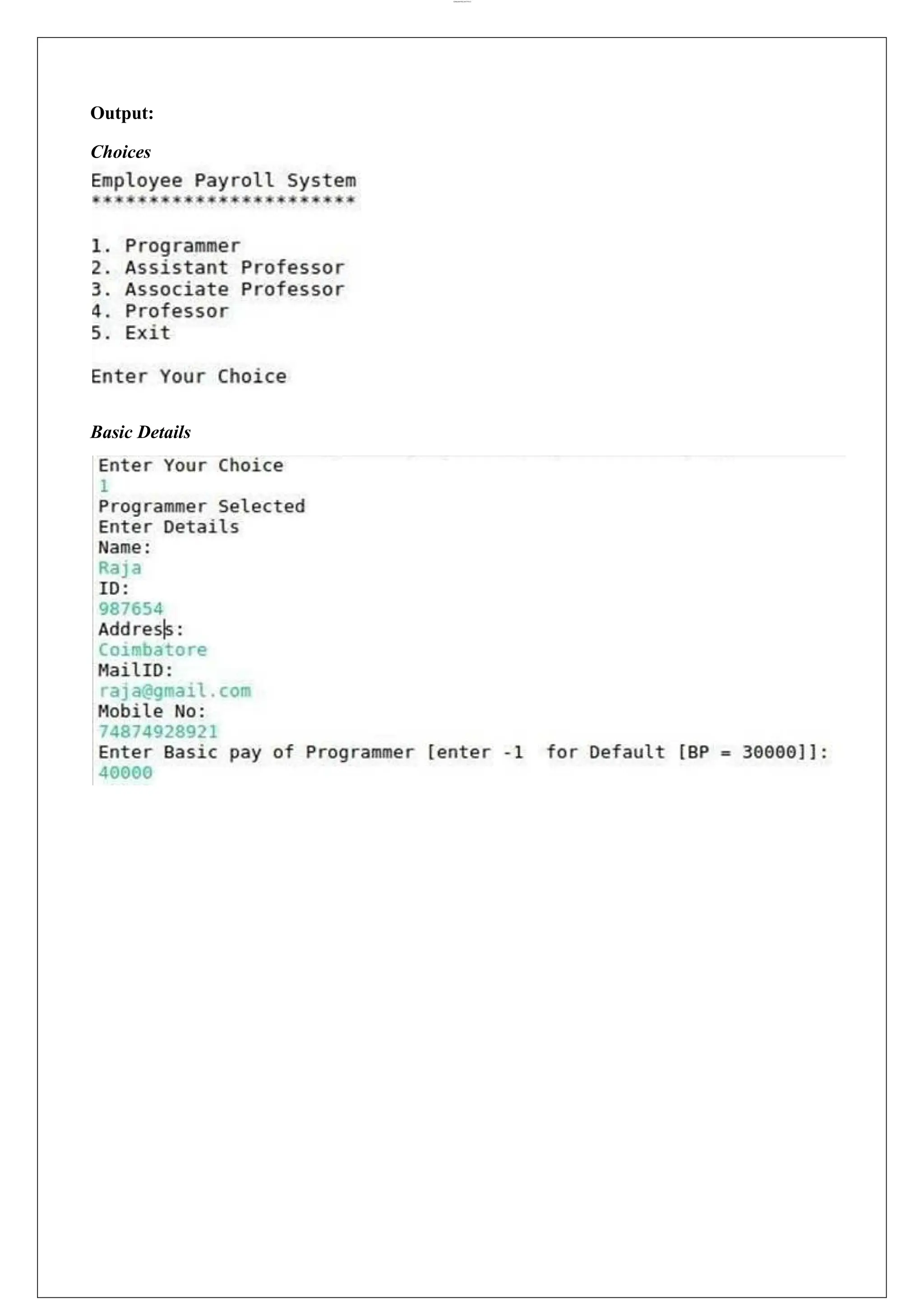
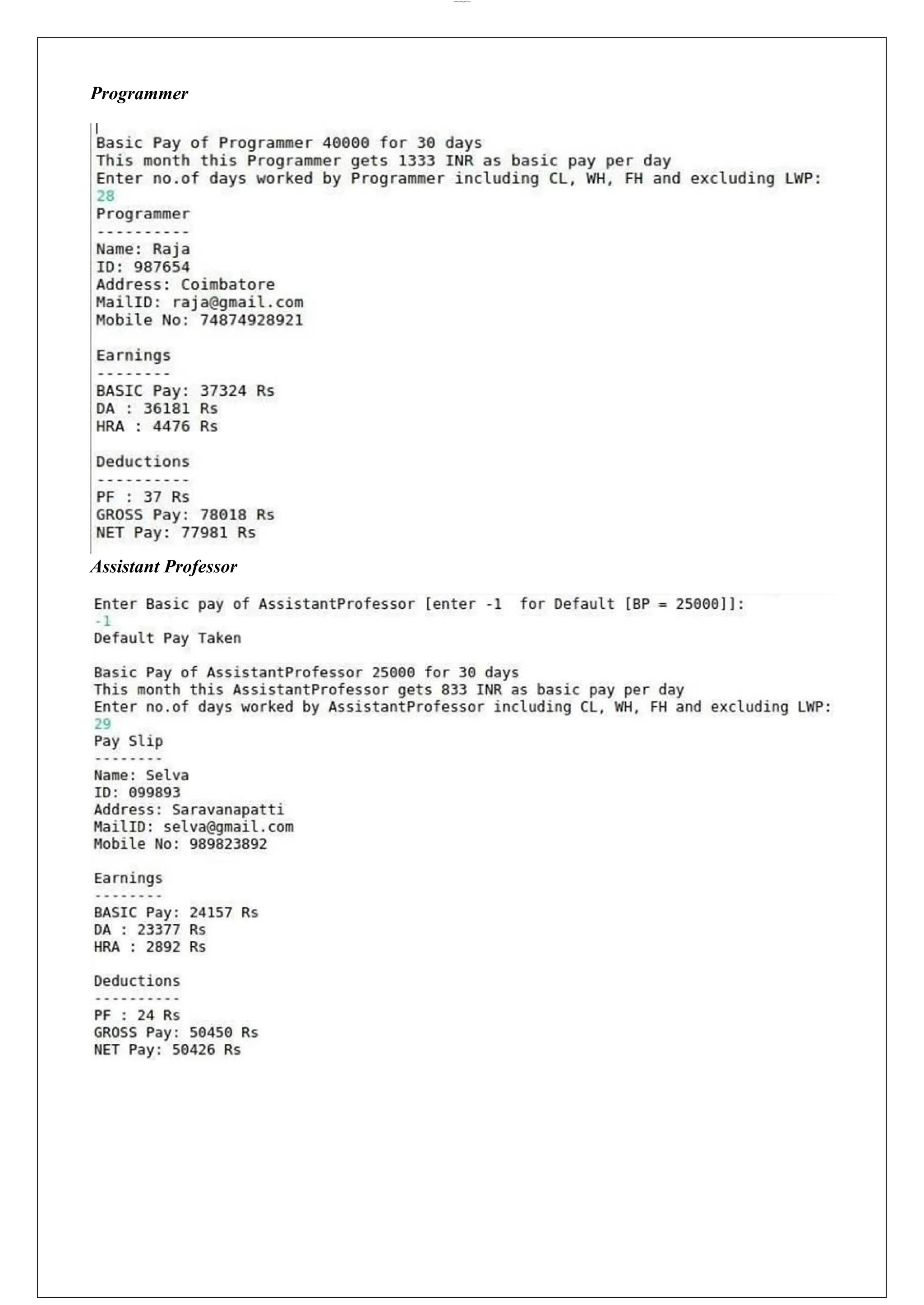
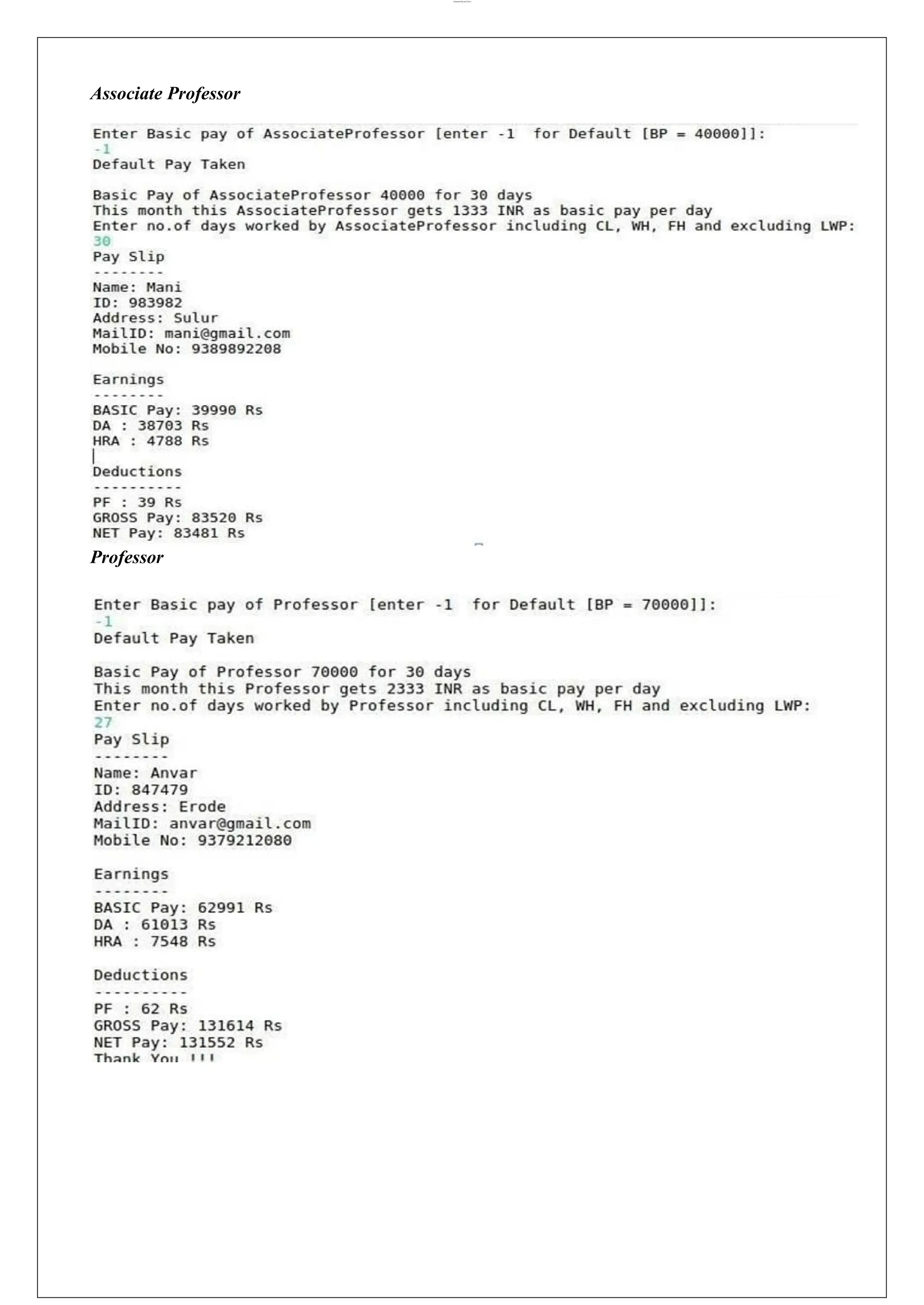

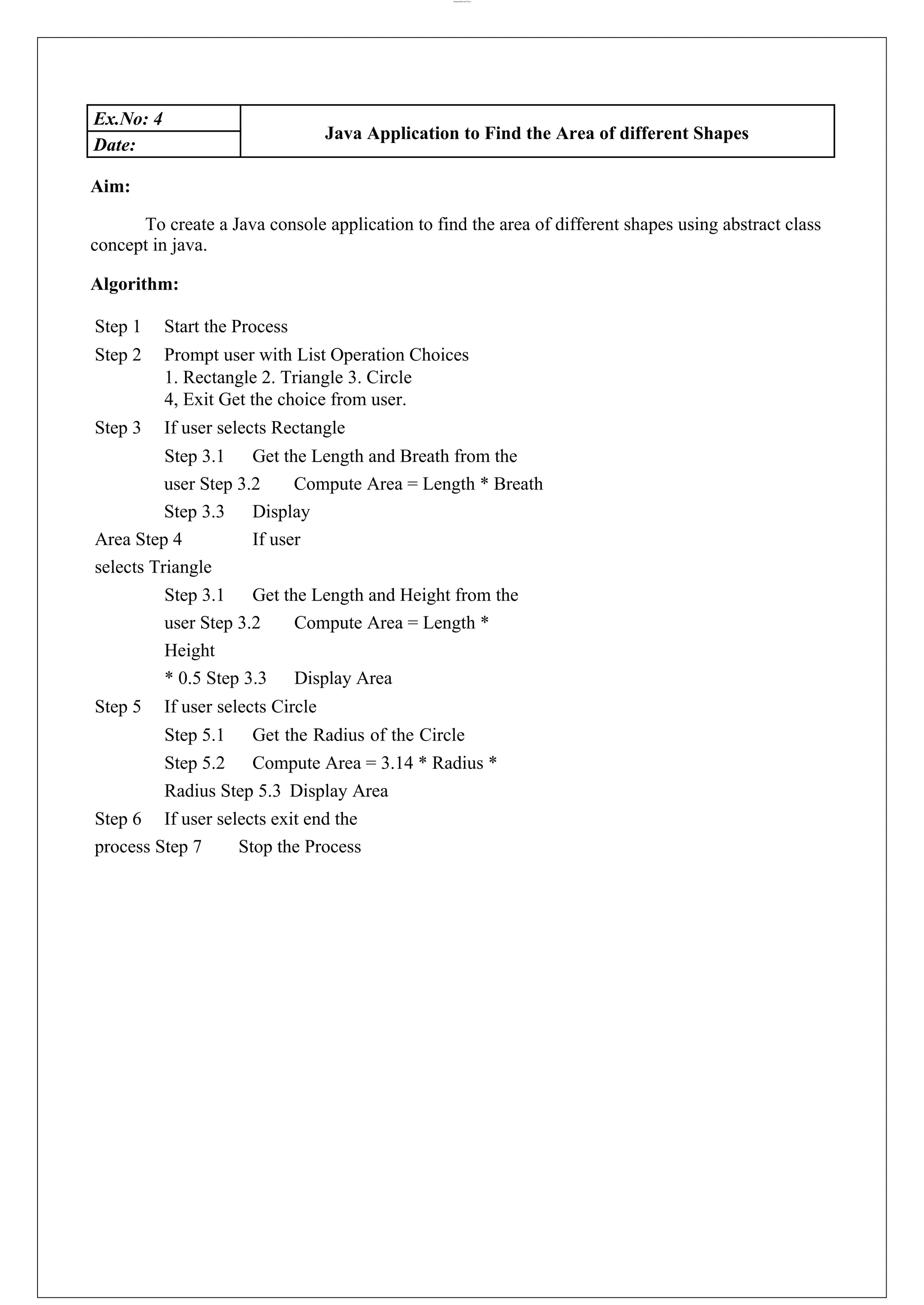
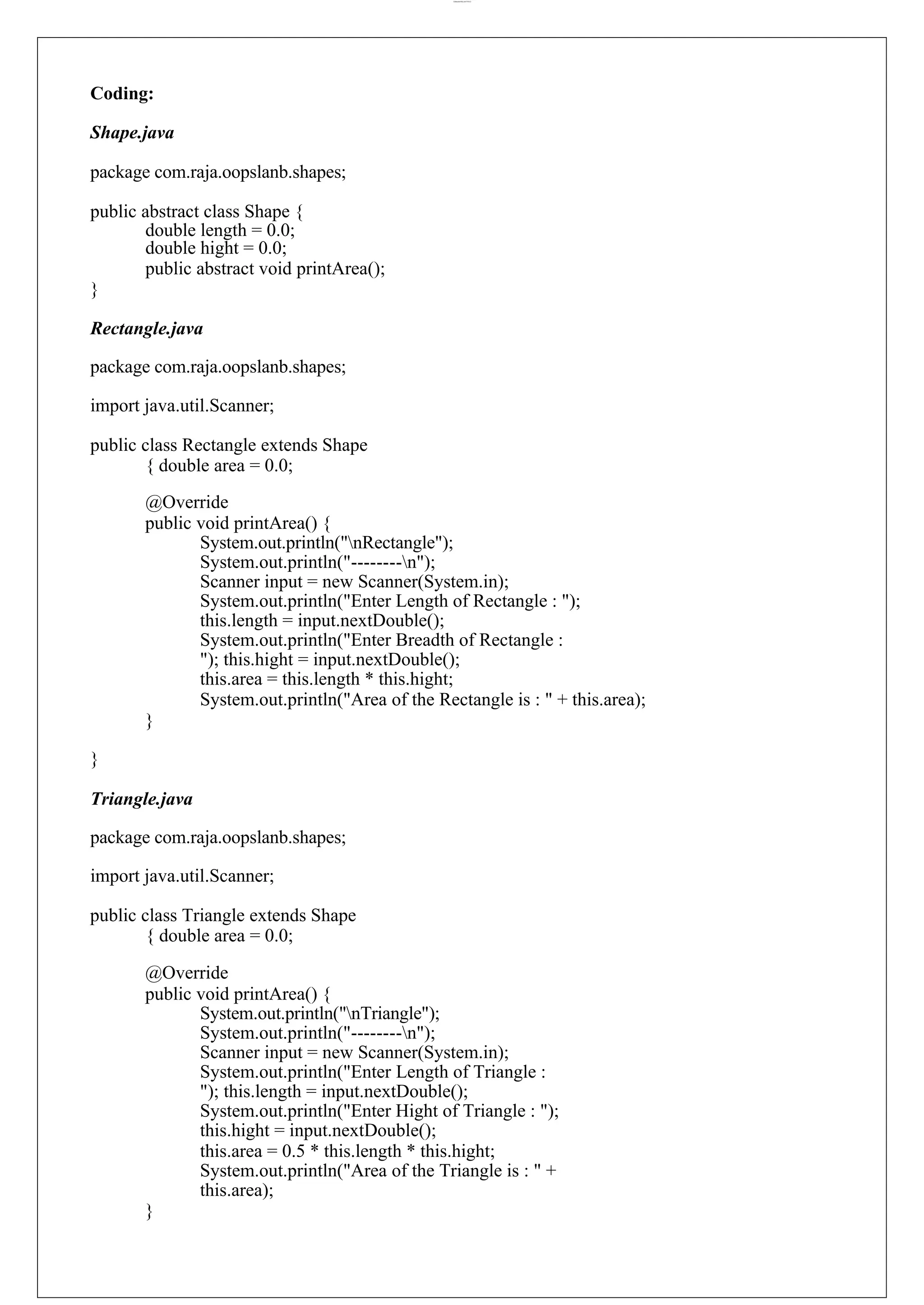
![lOMoARcPSD|44777612 } Circle.java package com.raja.oopslanb.shapes; import java.util.Scanner; public class Circle extends Shape { double area = 0.0; @Override public void printArea() { System.out.println("nCircle"); System.out.println("------n"); Scanner input = new Scanner(System.in); System.out.println("Enter Radius of Circle : "); this.length = input.nextDouble(); this.area = Math.PI * this.length * this.length; System.out.println("Area of the Circle is : " + this.area); } } Main.java import com.raja.oopslanb.shapes.Rectangle; import com.raja.oopslanb.shapes.Shape; import com.raja.oopslanb.shapes.Triangle; import java.util.Scanner; import com.raja.oopslanb.shapes.Circle; public class Main { public static void main(String[] args) { Scanner userInput = new Scanner(System.in); int choice = 0; do { System.out.println("Finding Area"); System.out.println("************"); System.out.println( "n1. Rectangle" + "n2. Triangle" + "n3. Circle" + "n4. Exit" + "nnEnter your choice: "); choice = userInput.nextInt(); switch (choice) { case 1: case 2: case 3: Shape rt = new Rectangle(); rt.printArea(); break; Shape tr = new Triangle(); tr.printArea(); break; Shape cr = new Circle();](https://image.slidesharecdn.com/cs3381-oops-lab-manual-wordf-240805065617-a87611fa/75/cs3381-object-oriented-programming-ab-manual-31-2048.jpg)
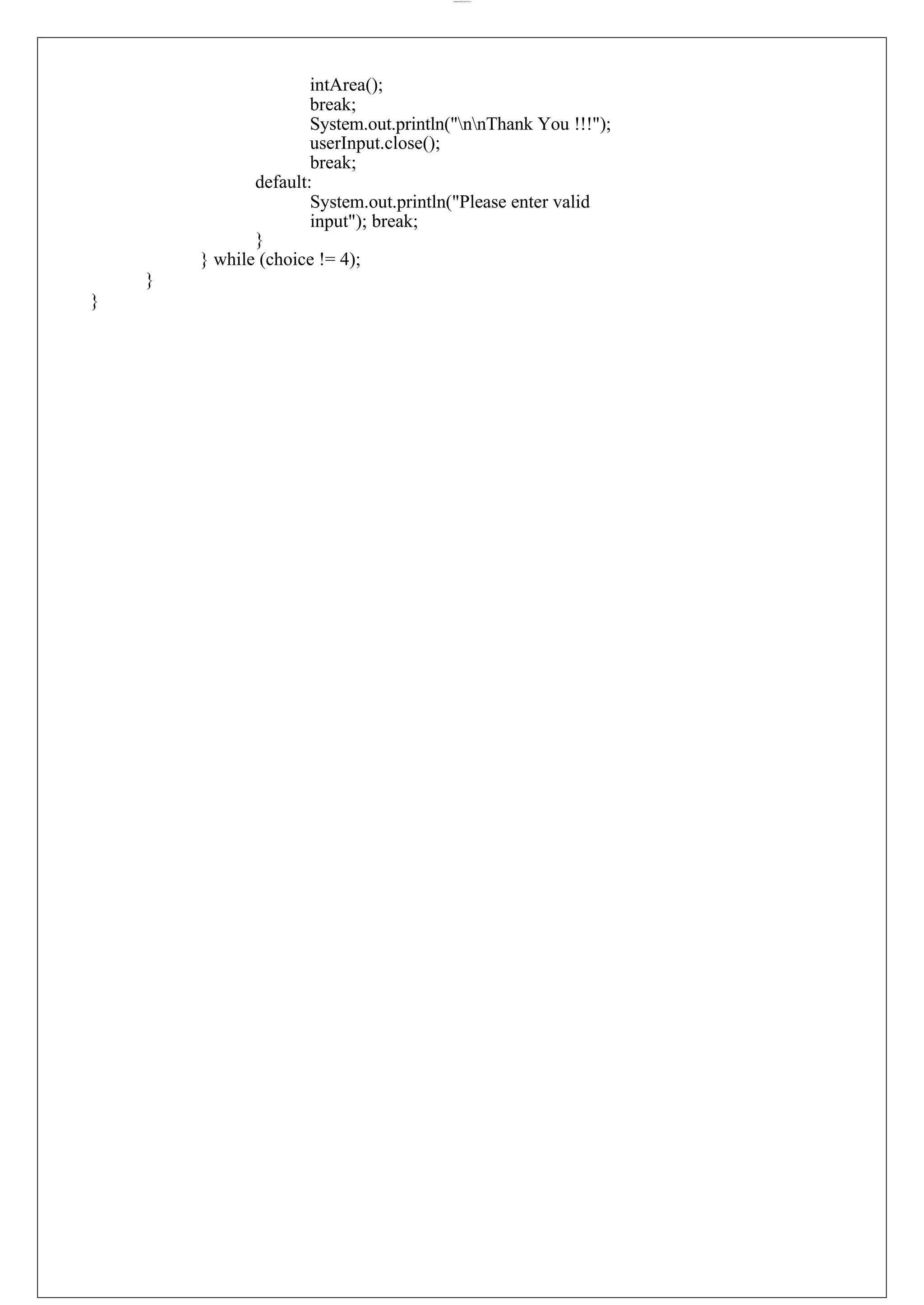
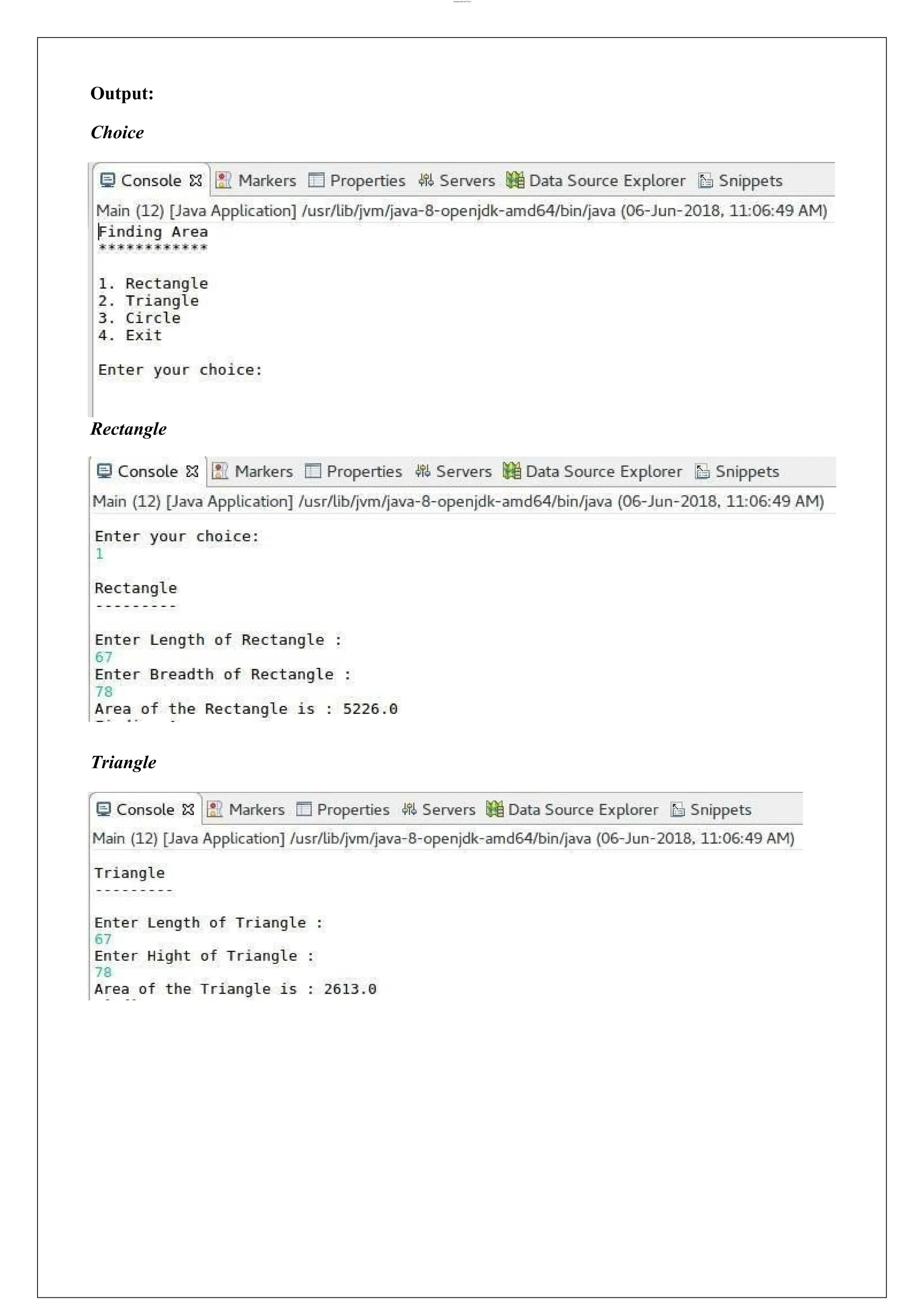
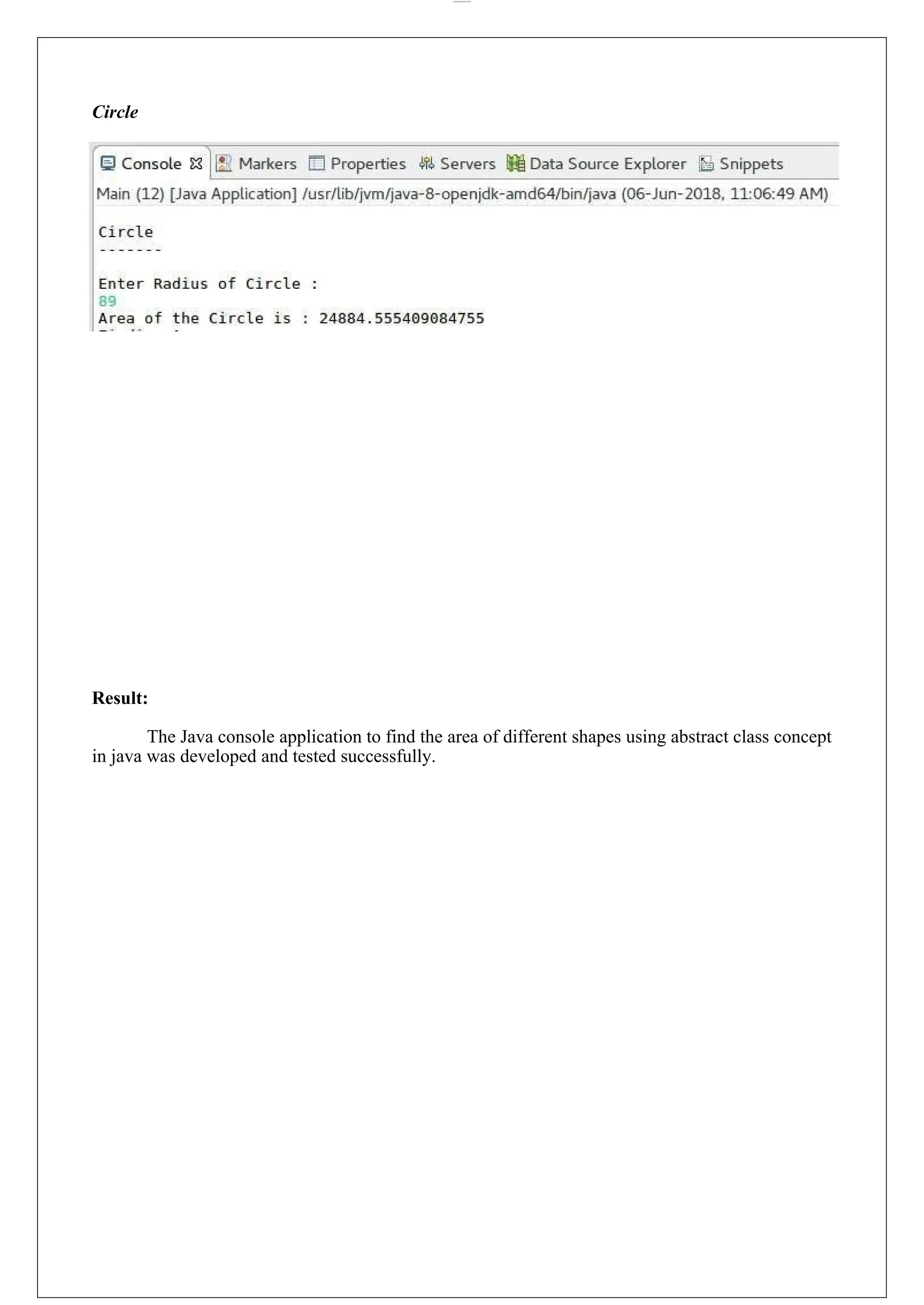
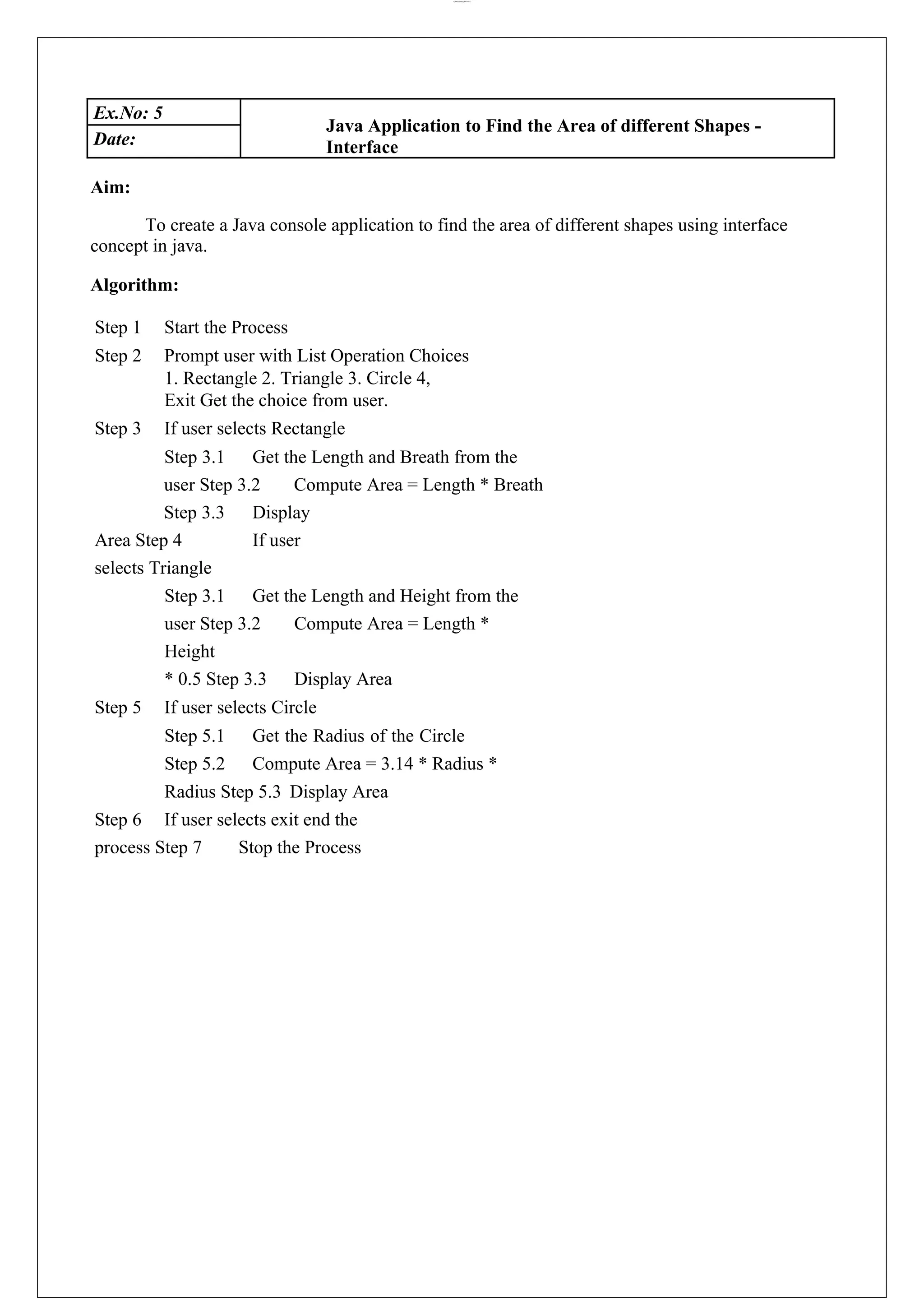
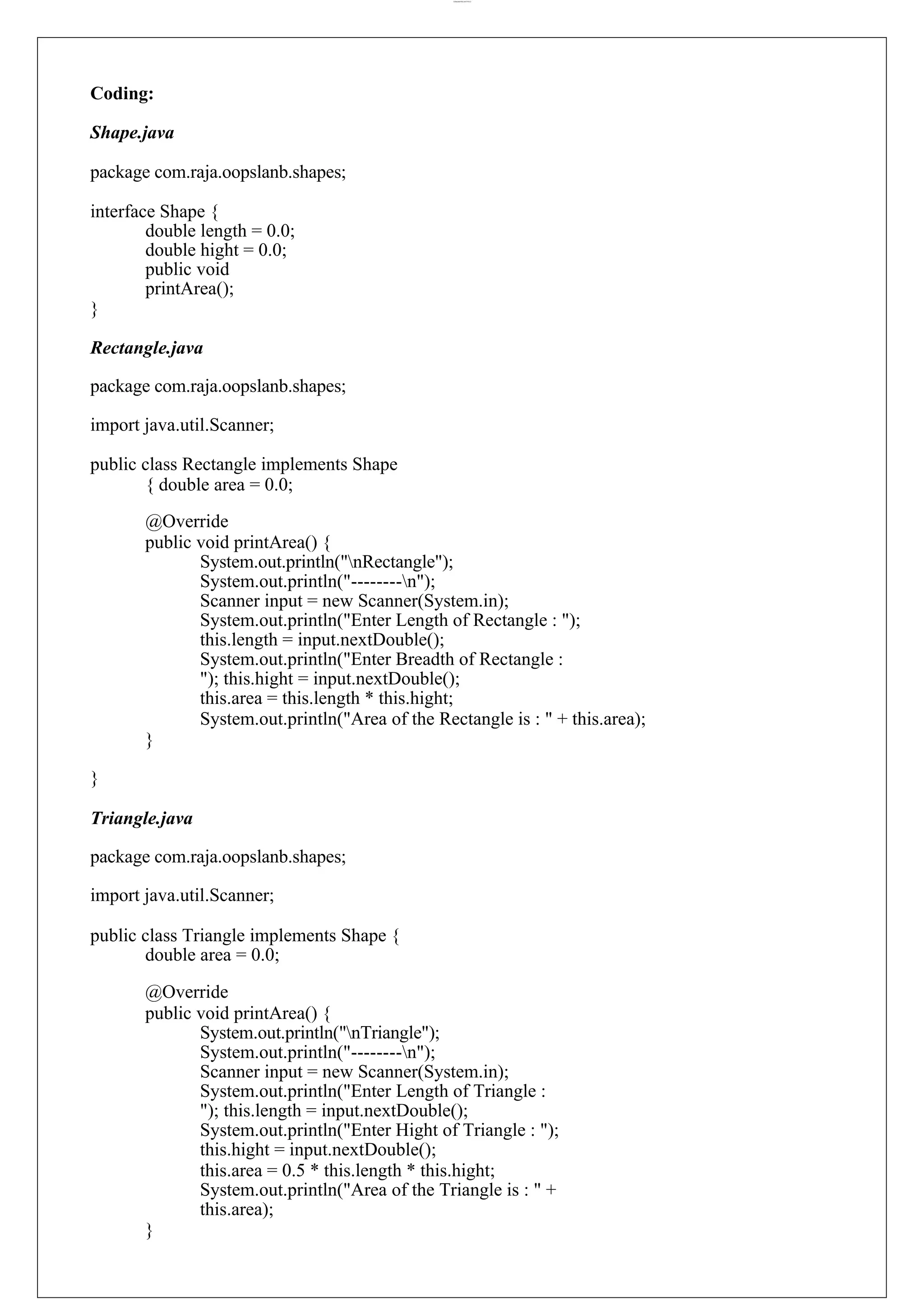
![lOMoARcPSD|44777612 } Circle.java package com.raja.oopslanb.shapes; import java.util.Scanner; public class Circle implements Shape { double area = 0.0; @Override public void printArea() { System.out.println("nCircle"); System.out.println("------n"); Scanner input = new Scanner(System.in); System.out.println("Enter Radius of Circle : "); this.length = input.nextDouble(); this.area = Math.PI * this.length * this.length; System.out.println("Area of the Circle is : " + this.area); } } Main.java import com.raja.oopslanb.shapes.Rectangle; import com.raja.oopslanb.shapes.Shape; import com.raja.oopslanb.shapes.Triangle; import java.util.Scanner; import com.raja.oopslanb.shapes.Circle; public class Main { public static void main(String[] args) { Scanner userInput = new Scanner(System.in); int choice = 0; do { System.out.println("Finding Area"); System.out.println("************"); System.out.println( "n1. Rectangle" + "n2. Triangle" + "n3. Circle" + "n4. Exit" + "nnEnter your choice: "); choice = userInput.nextInt(); switch (choice) { case 1: case 2: case 3: Shape rt = new Rectangle(); rt.printArea(); break; Shape tr = new Triangle(); tr.printArea(); break; Shape cr = new Circle(); case 4:](https://image.slidesharecdn.com/cs3381-oops-lab-manual-wordf-240805065617-a87611fa/75/cs3381-object-oriented-programming-ab-manual-37-2048.jpg)
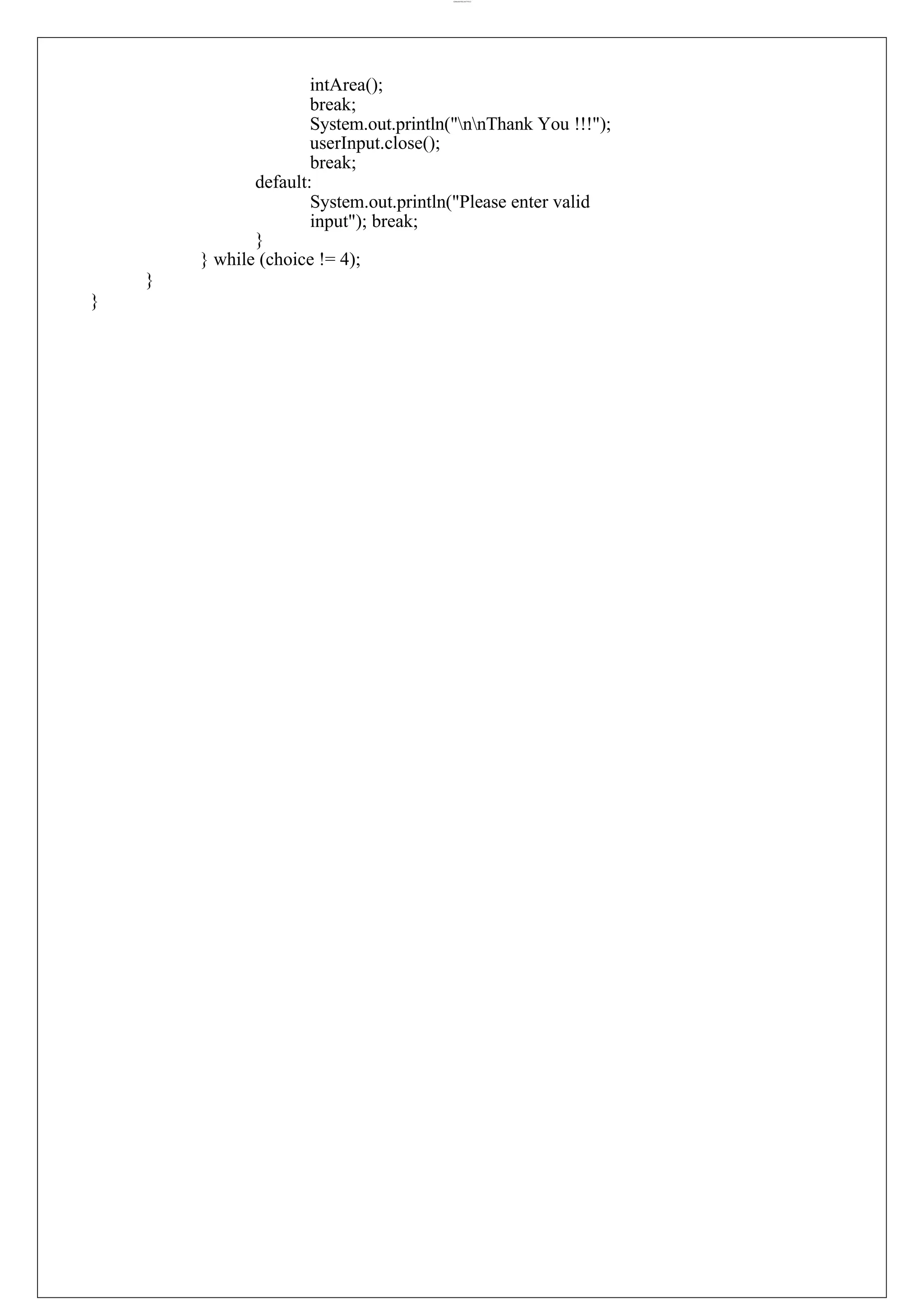
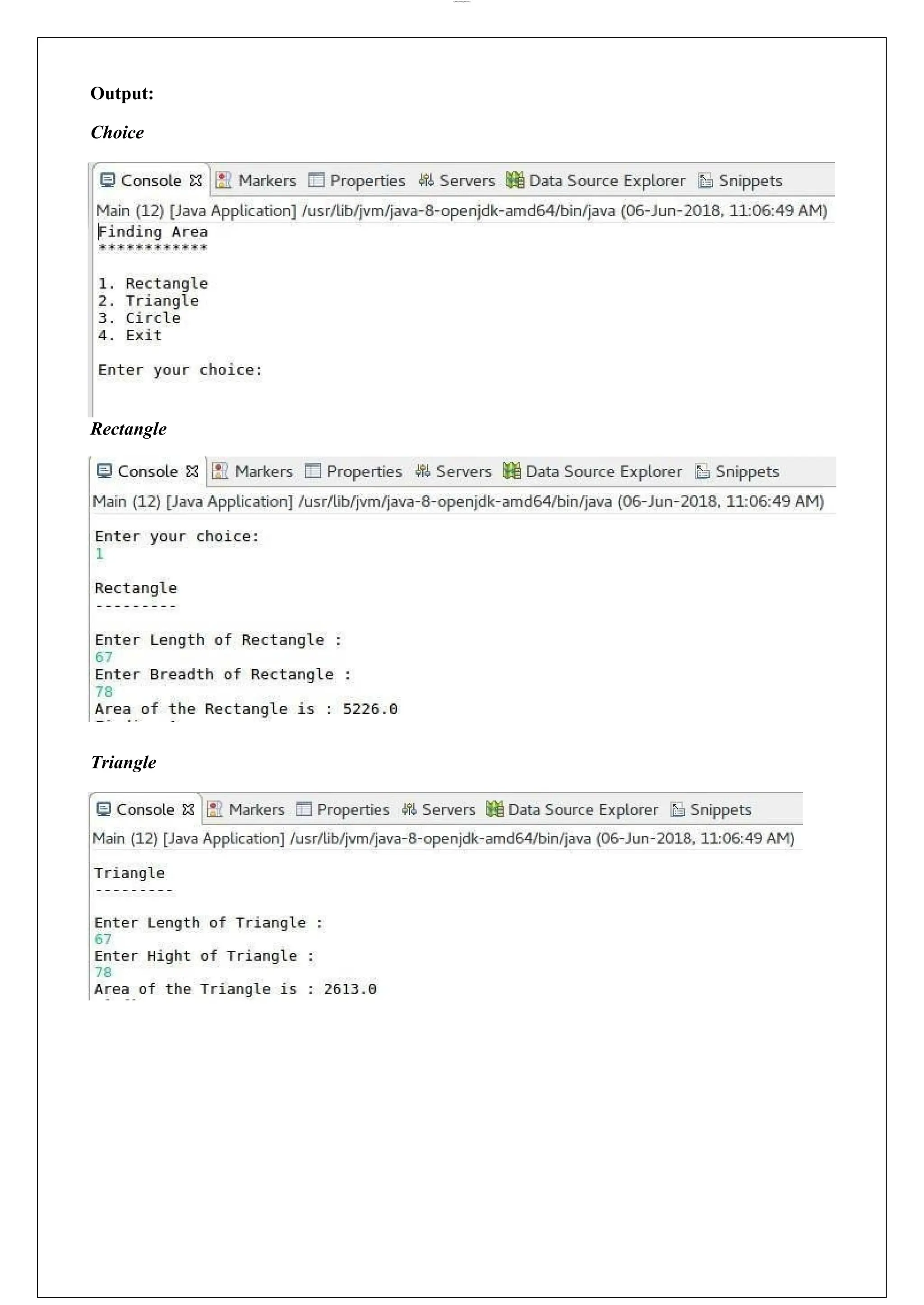
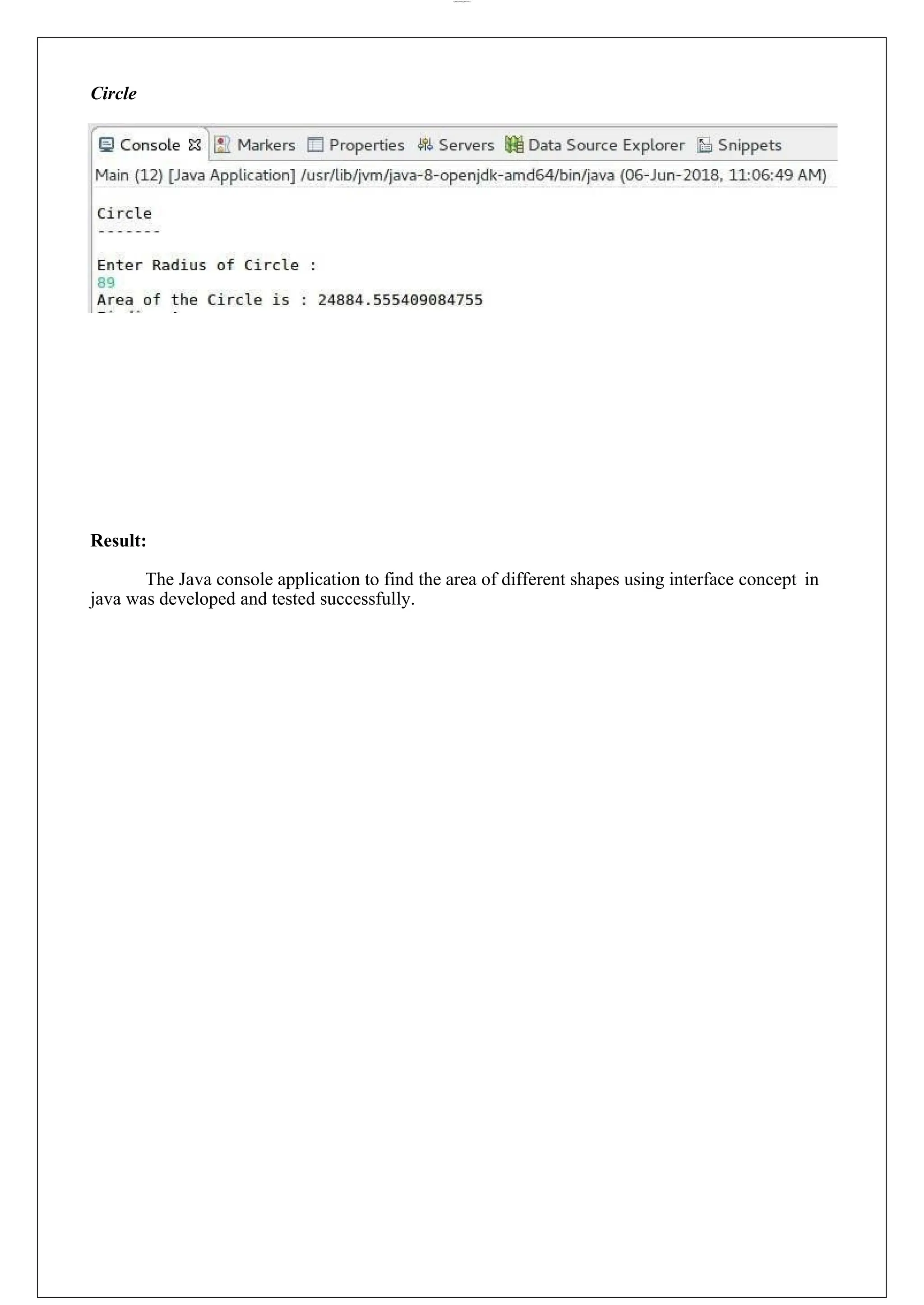
![lOMoARcPSD|44777612 Ex.No: 6 Bank Transaction System with User Exceptions Date: Aim: To create a Java console application for Banking transaction system that helps the users to do their credit and debit transactions and it rises user defined exception while encountering errors in transaction and also it should be solved using exception handling techniques. Algorithm: Step 1 Start the Process Step 2 Prompt user with List Operation Choices 1. Add Money 2. Get Money 3. Details 4. Exit Get the choice from user. Step 3 If user selects Add Money Step 3.1 Get the amount to be added to balance from the user Step 3.2 If the amount is less than 0 then throw Invalid Credit Exception and goto step 3.4 Step 3.3 Else add amount to balance and goto step 2 Step 3.4 Prompt user with “Enter valid credit amount” and goto step 3.1 Step 4 If user selects Get Money Step 4.1 Get the amount to be debited to balance from the user Step 4.2 If the amount is greater than existing balance then throw Invalid Debit Exception and goto step 4.4 Step 4.3 Else deduct amount from balance and goto step 2 Step 4.4 Prompt user with “Enter valid debit amount” and goto step 4.1 Step 5 If user selects Details then display Customer Details [Name, Account Number, Current Balance] Step 6 If user wants to exit display “Thank You !!!” and end process Step 7 Stop the Process](https://image.slidesharecdn.com/cs3381-oops-lab-manual-wordf-240805065617-a87611fa/75/cs3381-object-oriented-programming-ab-manual-41-2048.jpg)
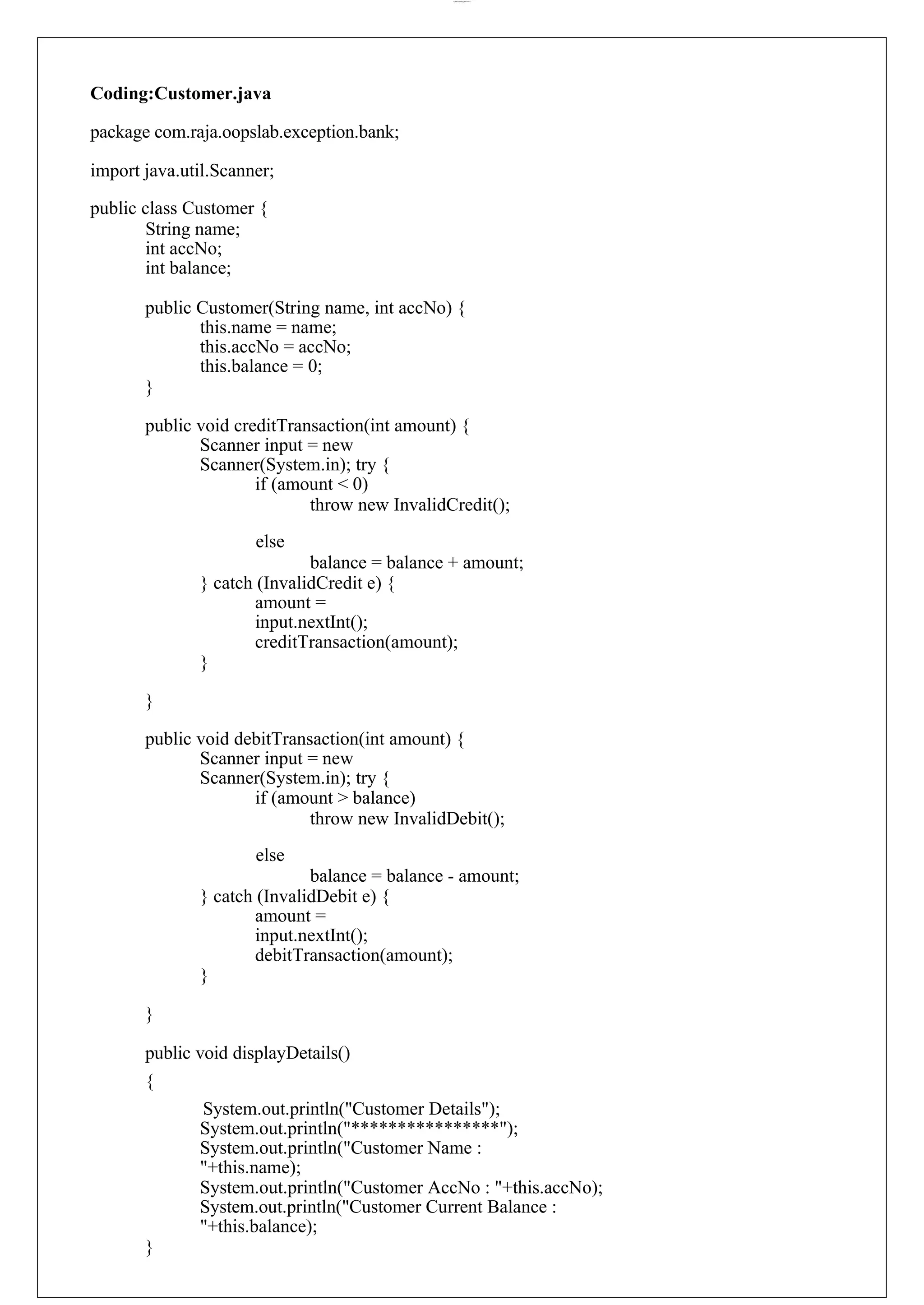
![lOMoARcPSD|44777612 } InvalidCredit.java package com.raja.oopslab.exception.bank; public class InvalidCredit extends Exception { public InvalidCredit() { System.out.print("Please enter valid credit amount"); } } InvalidDebit.java package com.raja.oopslab.exception.bank; public class InvalidDebit extends Exception { public InvalidDebit() { System.out.print("Please enter valid debit amount"); } } Main.java import java.util.Scanner; import com.raja.oopslab.exception.bank.*; public class Main { public static void main(String[] args) { Scanner input = new Scanner(System.in); String name; int acc_no; System.out.println("Enter Customer Name"); name = input.next(); System.out.println("Enter account number"); acc_no = input.nextInt(); Customer aCustomer = new Customer(name, acc_no); int choice = 0; while(choice != 4){ System.out.println("n1. Add Moneyn2. Get Moneyn3. Detailsn4. Exit"); choice = input.nextInt(); switch(choice) { case 1: system.out.println(“Enter the amount”); aCustomer.creditTransaction(input.nextInt(); break; case 2: system.out.println(“Enter the amount”); aCustomer.debitTransaction(input.nextInt(); break; case 3: aCustomer.displayDetails(); break; case 4: System.out.println("Thank You !!!"); break; }} }}](https://image.slidesharecdn.com/cs3381-oops-lab-manual-wordf-240805065617-a87611fa/75/cs3381-object-oriented-programming-ab-manual-43-2048.jpg)
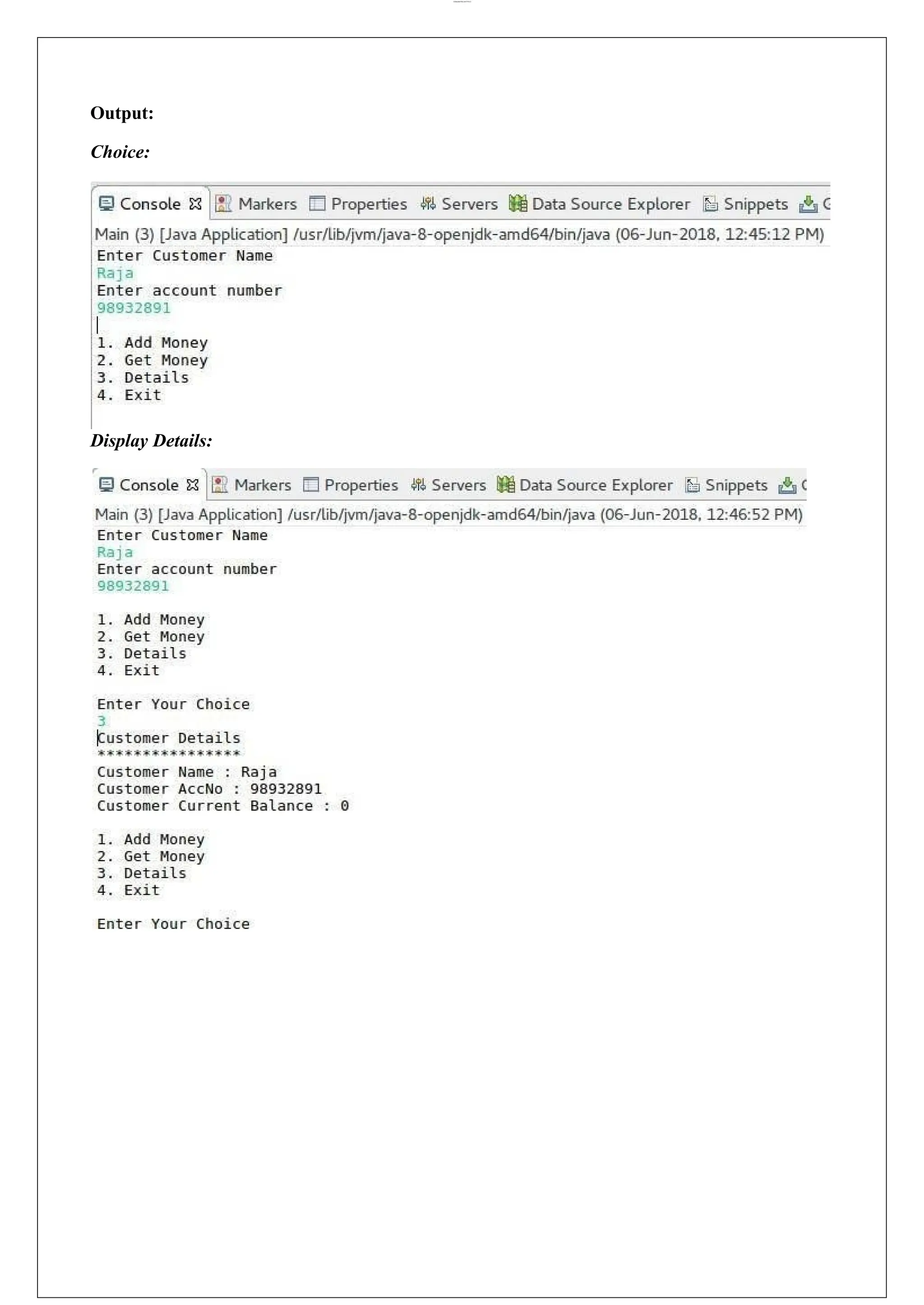
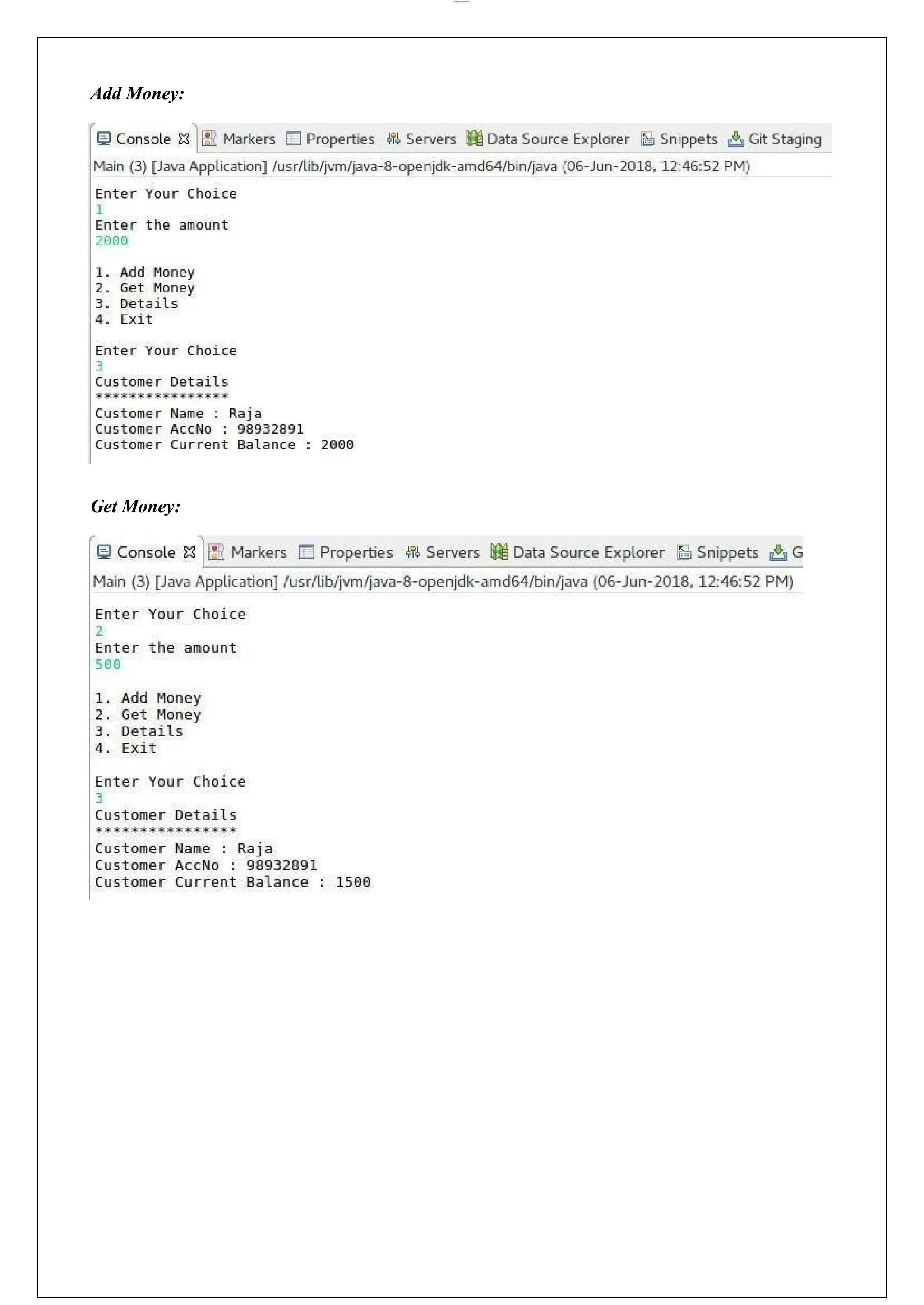
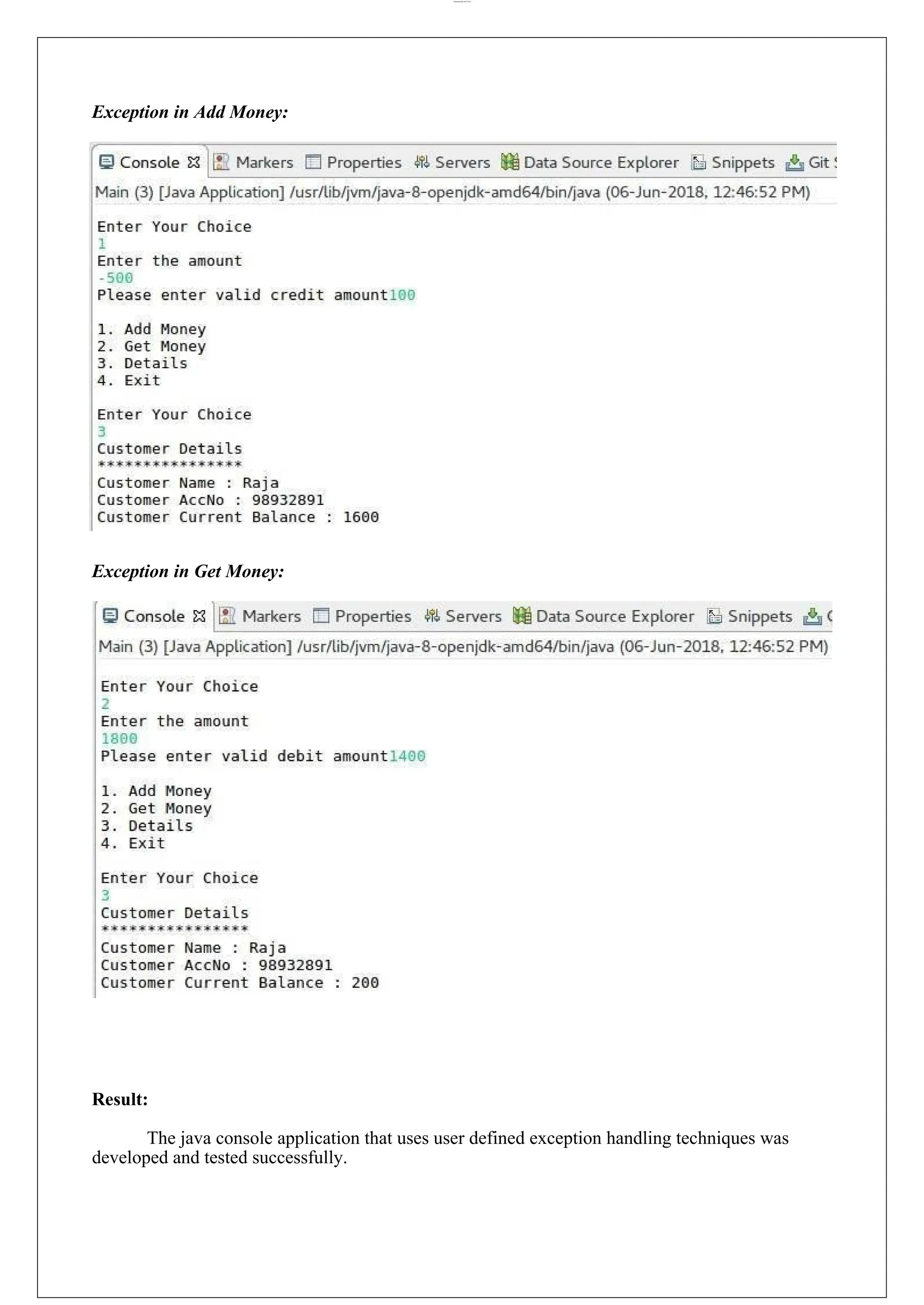
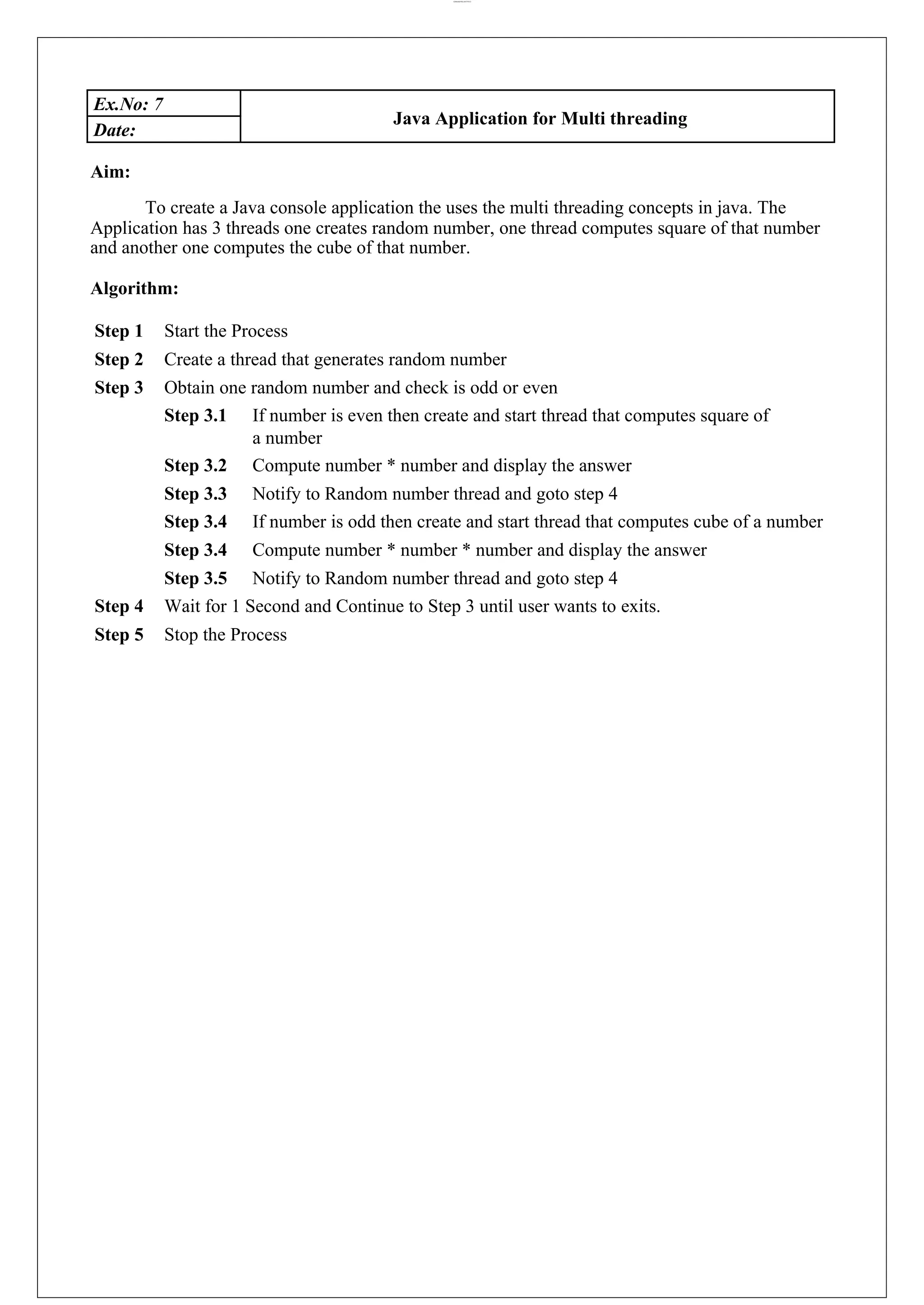
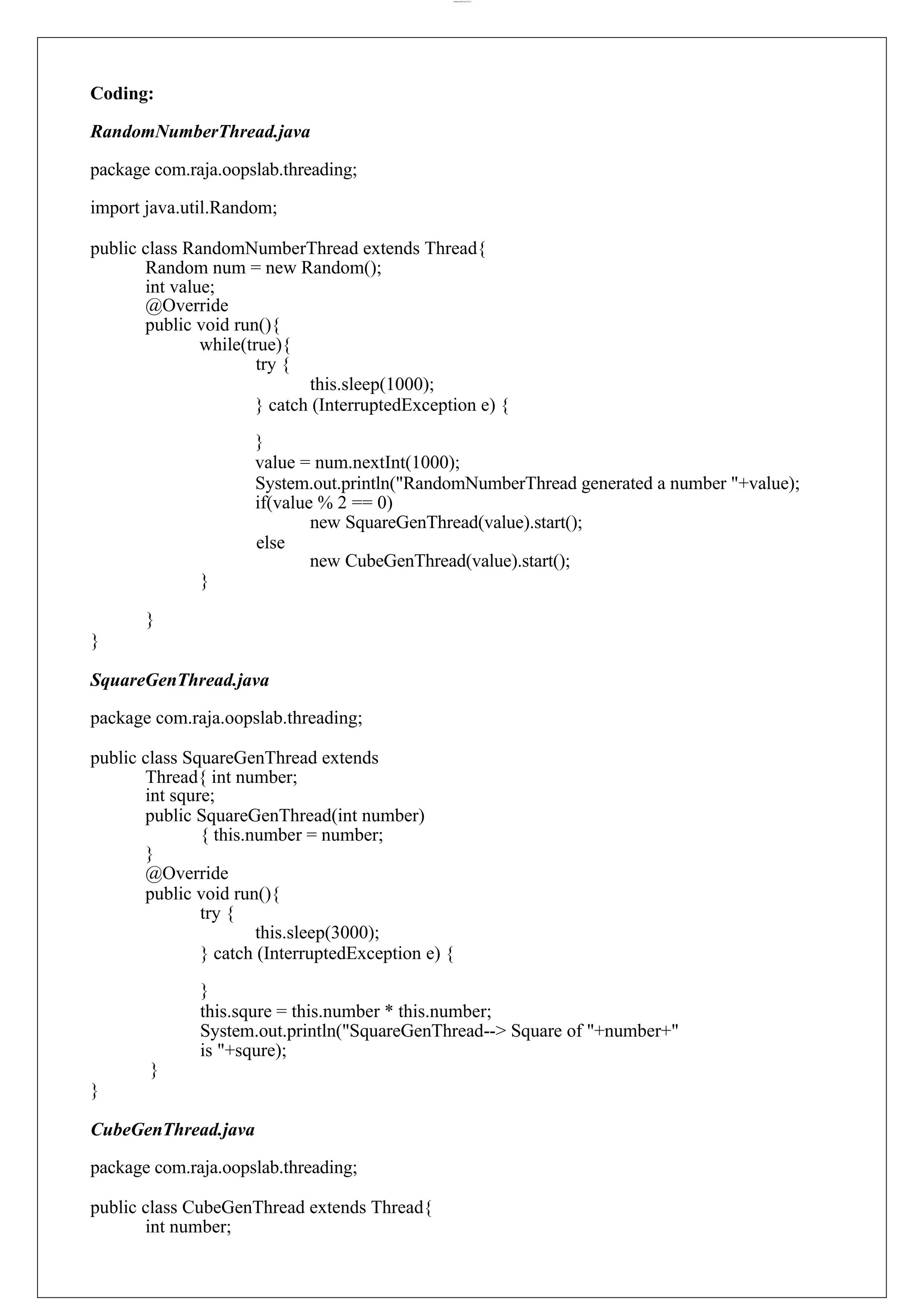
![lOMoARcPSD|44777612 int squre; public CubeGenThread(int number) { this.number = number; } @Override public void run(){ try { this.sleep(2000); } catch (InterruptedException e) { } this.squre = this.number * this.number * this.number; System.out.println("CubeGenThread--> Square of "+number+" is "+squre); } } Main.java import java.util.Random; import com.raja.oopslab.threading.RandomNumberThread; public class Main { public static void main(String[] args) { new RandomNumberThread().start(); } }](https://image.slidesharecdn.com/cs3381-oops-lab-manual-wordf-240805065617-a87611fa/75/cs3381-object-oriented-programming-ab-manual-49-2048.jpg)
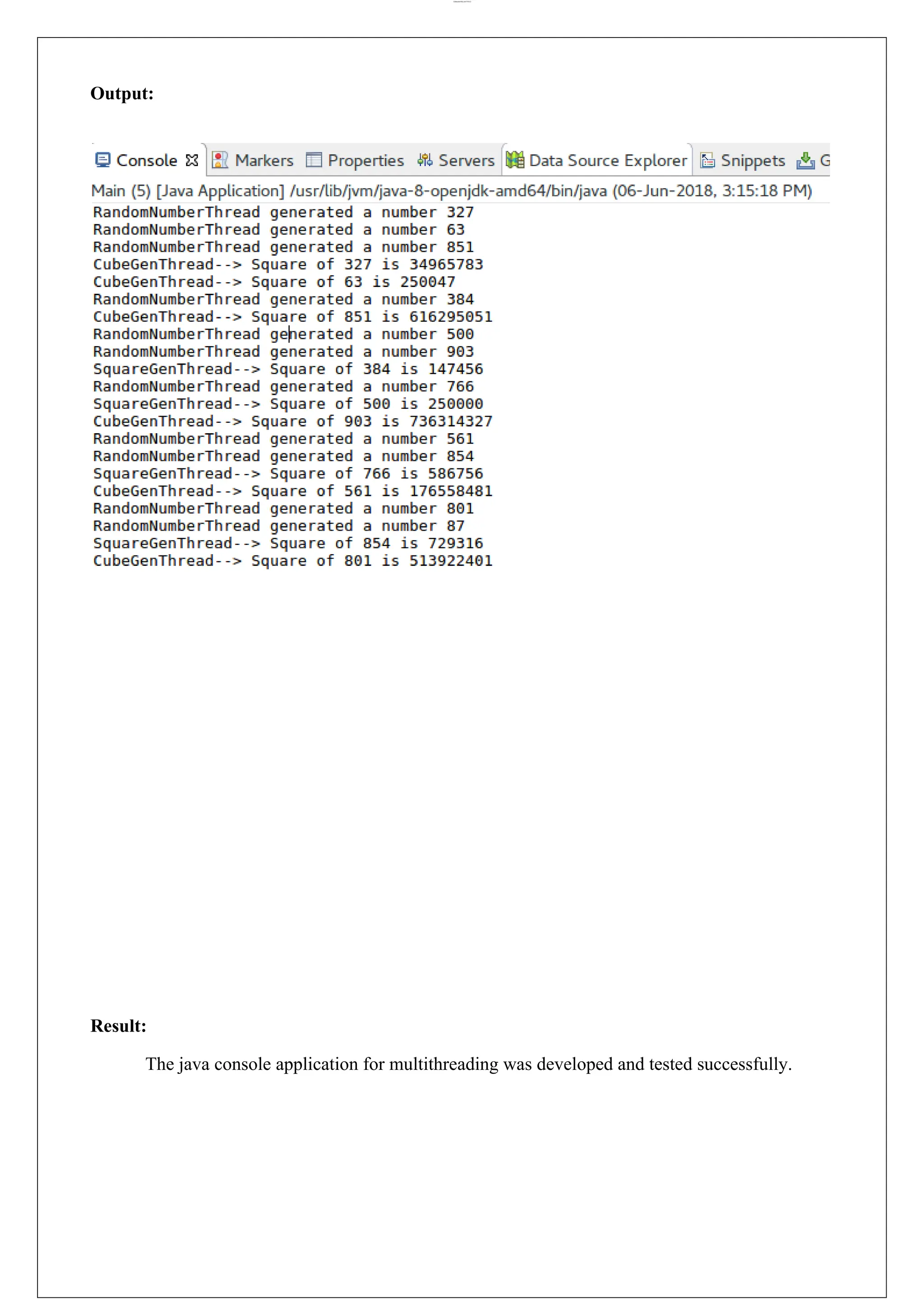
![lOMoARcPSD|44777612 Ex.No: 8 Java Application for File Handling Date: Aim: To create a Java console application to handle the files and find the file properties [Availability, Readable or Writeable or Both, Length of the File]. Algorithm: Step 1 Start the Process Step 2 Prompt the user to enter the file name with path Step 3 Get the file name Step 3.1 Check the file is exits Step 3.2 If file exists then proceed to step 3.3 else proceed to step 3.8 Step 3.3 Check the File is Both Readable and Writeable Step 3.4 If yes display file is “Read and Writeable” Step 3.5 Else check is readable if yes display “Read Only” else move to step 3.6 Step 3.6 Else check is writeable if yes display “Write Only” Step 3.7 Compute file size and display Step 3.8 If file not existing then display “File Not Found” Step 4 Stop the Process](https://image.slidesharecdn.com/cs3381-oops-lab-manual-wordf-240805065617-a87611fa/75/cs3381-object-oriented-programming-ab-manual-51-2048.jpg)
![lOMoARcPSD|44777612 Coding: UserFileHandler.java package com.raja.oopslab.files; import java.io.File; public class UserFileHandler{ File aFile; boolean isReadable = false; boolean isWriteable = false; boolean isExists = false; int length = 0; public UserFileHandler(String path) { aFile = new File(path); this.isExists = aFile.exists(); this.isReadable = aFile.canRead(); this.isWriteable =aFile.canWrite(); this.length = (int) aFile.length(); } public void fileDetails(){ if(isExists){ System.out.println("The File "+aFile.getName()+" is Available at:"+aFile.getParent()); if(isReadable && isWriteable) System.out.println("File is Readable and Writeable"); else if(isReadable) System.out.println("File is Only Readable"); else if(isWriteable) System.out.println("File is Only Writeable"); System.out.println("Total length of the file is :"+this.length+" bytes"); } else } } System.out.println("File does not exists "); Main.java import java.io.File; import java.util.Scanner; import com.raja.oopslab.files.*; public class Main { public static void main(String[] args) { String file_path = null; Scanner input = new Scanner(System.in); System.out.println("File Handler"); System.out.println("************"); System.out.println("Enter the file path"); file_path = input.next(); new UserFileHandler(file_path).fileDetails(); } }](https://image.slidesharecdn.com/cs3381-oops-lab-manual-wordf-240805065617-a87611fa/75/cs3381-object-oriented-programming-ab-manual-52-2048.jpg)
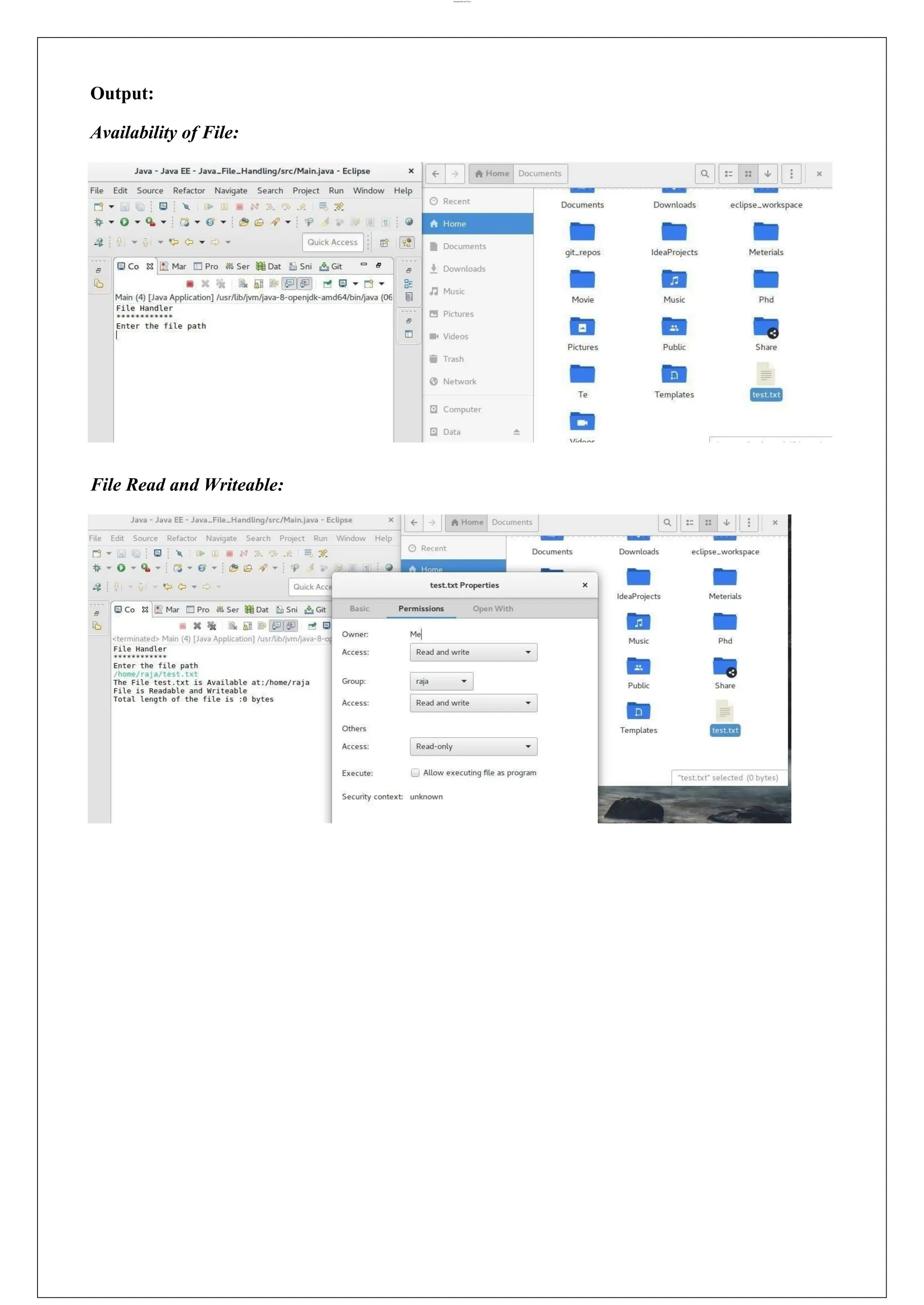
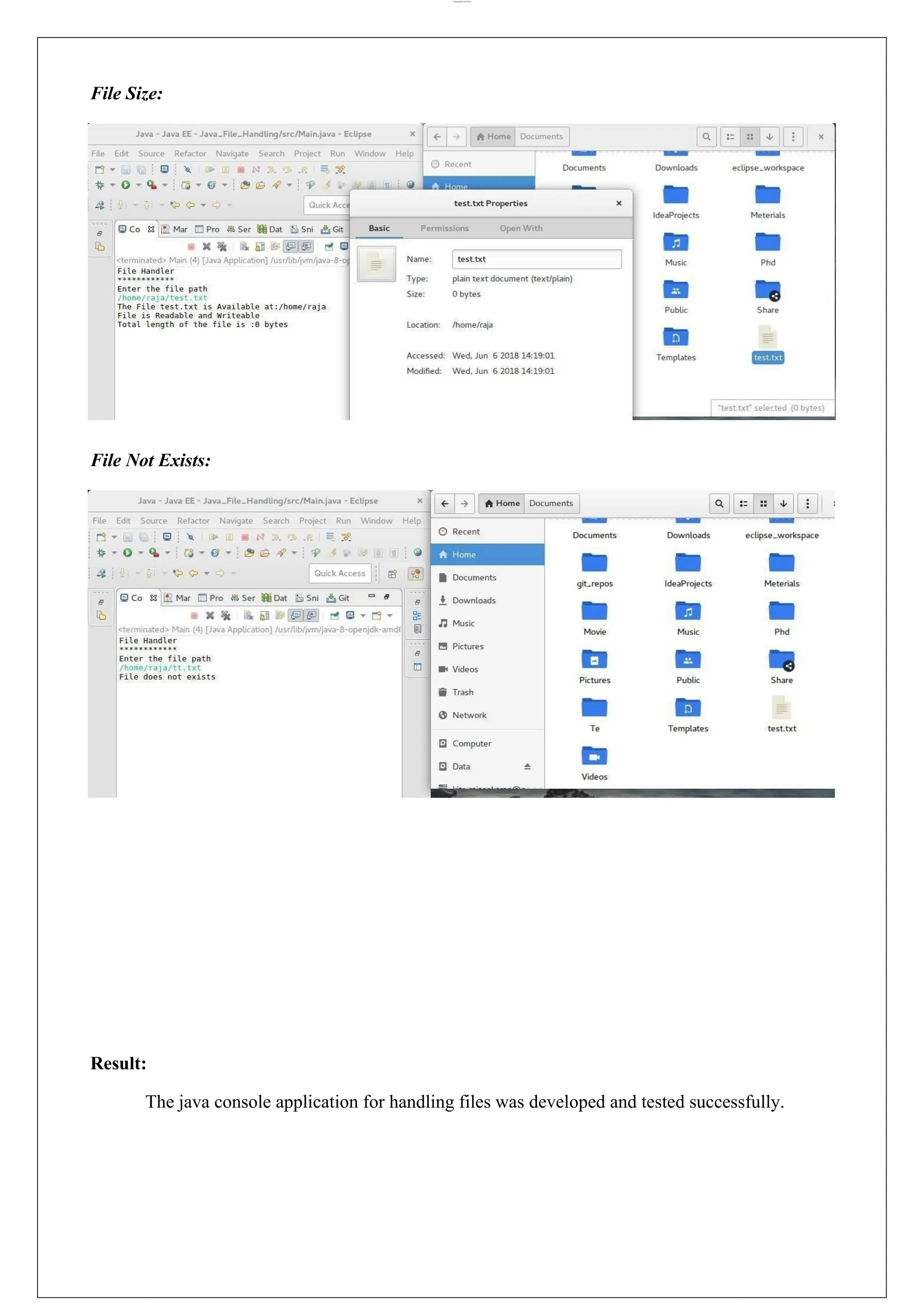
![lOMoARcPSD|44777612 Ex.No: 9 Java Application for Generic Max Finder Date: Aim: To create a Java console application that finds the maximum in a array based on the type of the elements using generic functions in java. Algorithm: Step 1 Start the Process Step 2 Create a array of number and array of strings and pass it to generic function. Step 3 If the array is Integer type Step 3.1 Assume first element as MAX Step 3.2 Compare [Numeric Perspetive] this element with MAX Step 3.3 If it is greater than MAX then store current element as MAX Step 3.4 Else do nothing Step 3.5 Goto step 3.1 until all the elements has been processed. Step 4 If the array is String type Step 4.1 Assume first element as MAX Step 4.2 Compare [Dictionary Perspective] this element with MAX Step 4.3 If it is greater than MAX then store current element as MAX Step 4.4 Else do nothing Step 4.5 Goto step 3.1 until all the elements has been processed. Step 5 Stop the Process](https://image.slidesharecdn.com/cs3381-oops-lab-manual-wordf-240805065617-a87611fa/75/cs3381-object-oriented-programming-ab-manual-55-2048.jpg)
![lOMoARcPSD|44777612 Coding: class GenericMax { public <T extends Comparable<T>> void maxFinder (T[] array){ T max = array[0]; for(T element: array){ System.out.println(element); if(element.compareTo(max) > 0) max = element; } System.out.println("Max is : "+max); } } public class Main { public static void main(String[] args) { GenericMax max = new GenericMax(); Integer[] numbers = {14,3,42,5,6,10}; String[] strings = {"R","Ra","Raj"}; max.maxFinder(numbers); max.maxFinder(strings); } } Output: Result: The java console application for finding generic max of given elements was developed and tested successfully.](https://image.slidesharecdn.com/cs3381-oops-lab-manual-wordf-240805065617-a87611fa/75/cs3381-object-oriented-programming-ab-manual-56-2048.jpg)
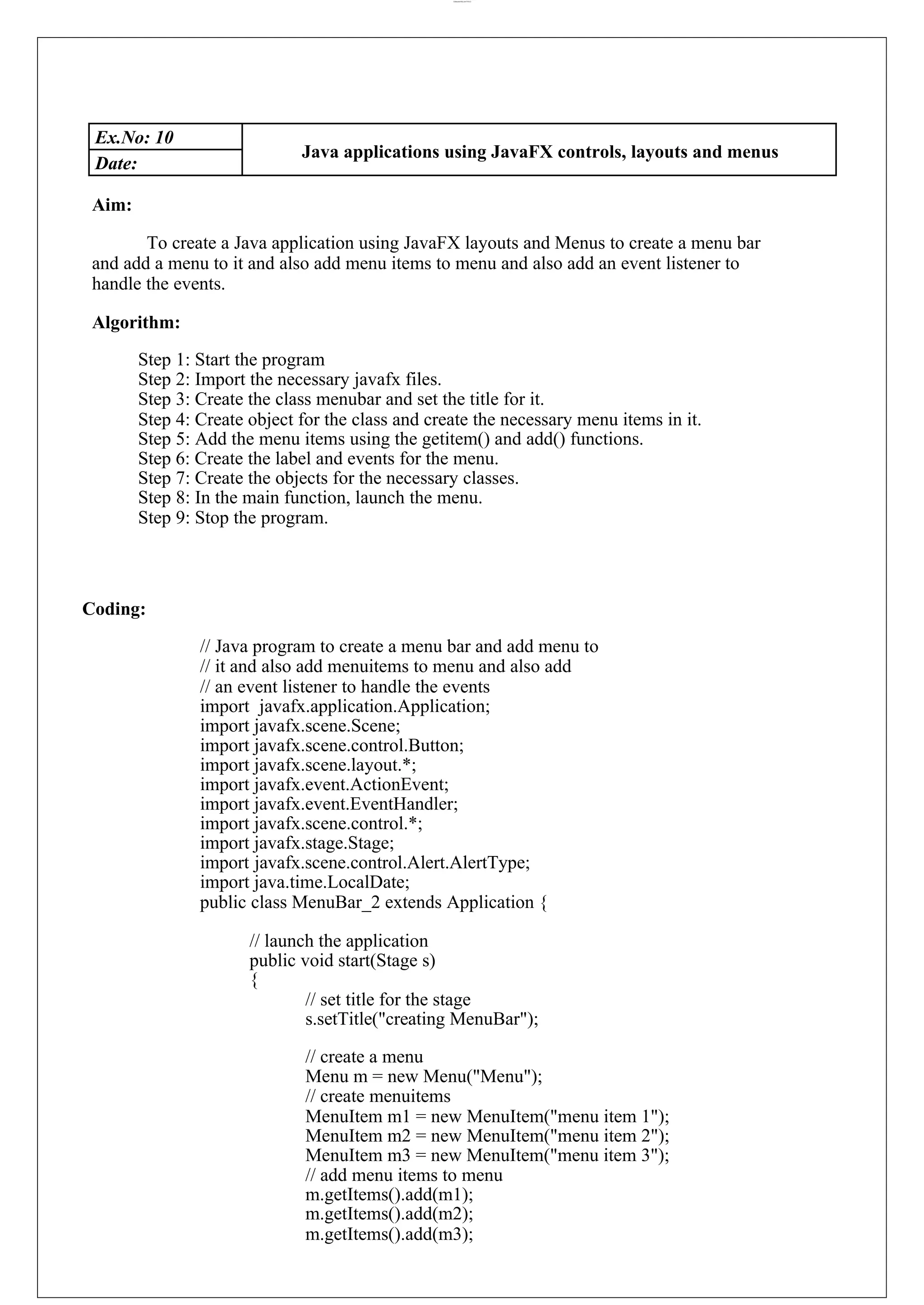
![lOMoARcPSD|44777612 // label to display events Label l = new Label("tttt"+ "no menu item selected"); // create events for menu items // action event EventHandler<ActionEvent> event = new EventHandler<ActionEvent>() { public void handle(ActionEvent e) { l.setText("tttt" + ((MenuItem)e.getSource()).getText() +" selected"); } }; // add event m1.setOnAction(event); m2.setOnAction(event); m3.setOnAction(event); // create a menubar MenuBar mb = new MenuBar(); // add menu to menubar mb.getMenus().add(m); // create a VBox VBox vb = new VBox(mb, l); // create a scene Scene sc = new Scene(vb, 500, 300); // set the scene s.setScene(sc); s.show(); } public static void main(String args[]) { // launch the application launch(args); } }](https://image.slidesharecdn.com/cs3381-oops-lab-manual-wordf-240805065617-a87611fa/75/cs3381-object-oriented-programming-ab-manual-58-2048.jpg)
